2014 Flyway Film Festival
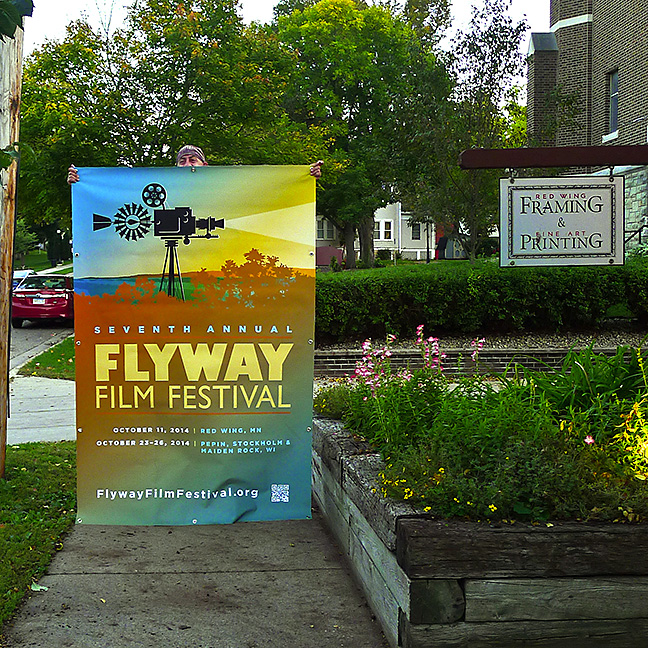
Every year we take this photo because every year we
like to be involved in the Flyway Film
Festival.
This year the Festival will continue to grow and we
are delighted to be a small part of it.
2013 Flyway Film Festival
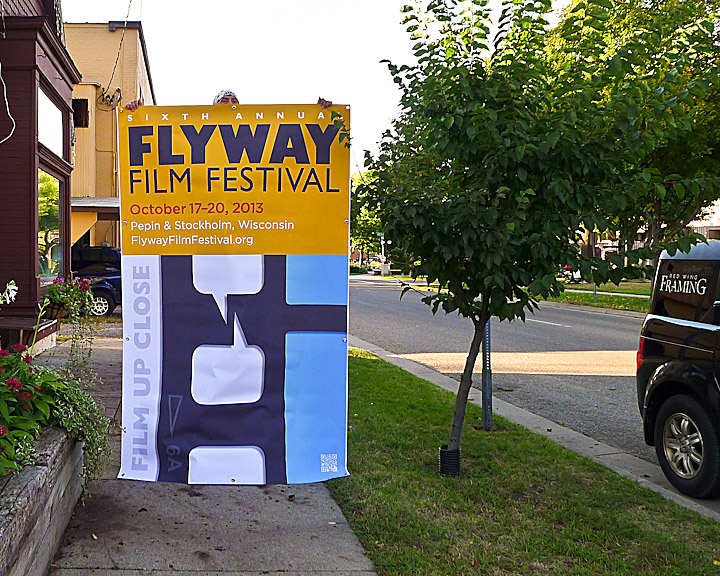
The Flyway Film
Festival is still one of our favorite events each
year. Each year it continues to improve and this year
will be no exception.
We love to participate because we love
films.
2013 resolutions...
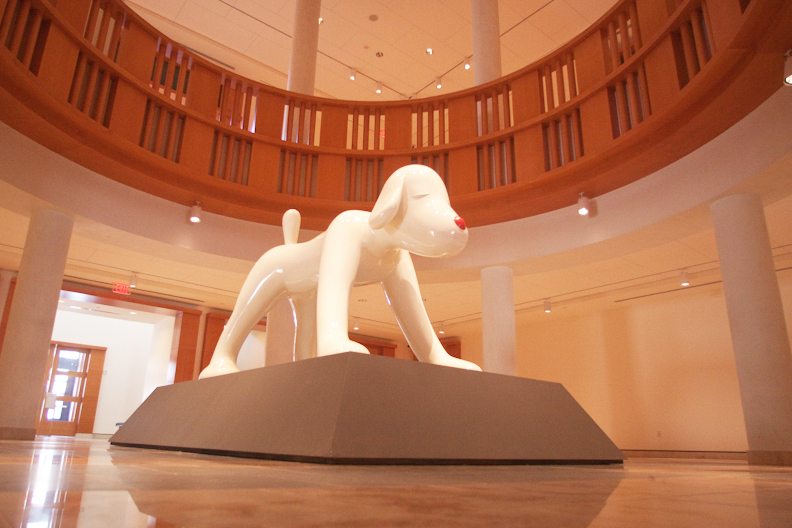
1) I will enjoy the buffet.
2) I will come back again. Thank you as well.
3) I will not smoke and be younger than the age of 16
as I dispense fuel.
4) I will floss twice a day, every day, the entire
week before my next dental exam.
That's all I got.
=============
Actually, 2013 is ramping up to be a very ambitious
year for several reasons.
Life is not simple, but it should be enjoyed.
Creativity is a uniquely human delight that drives
this enjoyment.
"Your Dog" by Yoshitomo Nara is a personal favorite.
It is in one of the rotunda galleries of the Minneapolis Institute of
Arts.
It completely captures how the world must look from a
child's perspective. You cannot help but enjoy this
and feel the wonderment of it all.
Happy new year!
Busy, busy , busy...
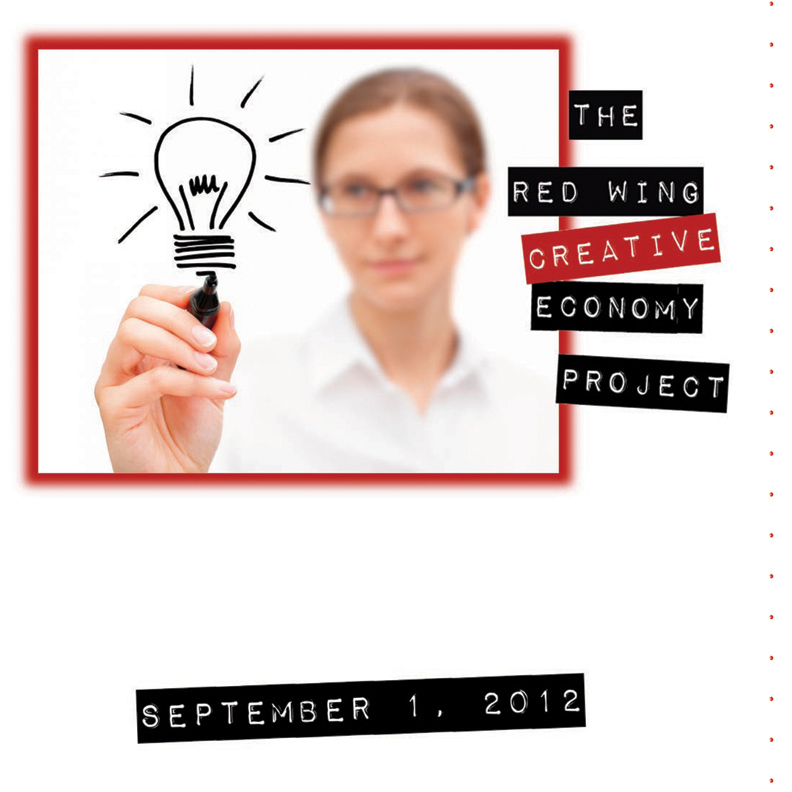
It
has been busier here than it might appear.
Earlier this year, we became involved in a project to
try and measure the local Creative Economy and
contrast it to other communities. Armed with this
information, the goal becomes to make defensible
recommendations going forward.
This is important to our business for obvious
reasons, but it is also important to the community
because this is where the economy is growing very
rapidly.
We couldn't (or even shouldn't) do a significant
project like this alone. We partnered with the
Southern Minnesota Initiative Foundation, Red Wing
Downtown Main Street, Inc., Anderson Center at Tower
View, Red Wing Arts Association, ArtReach and the
Sheldon Theatre of Performing Arts.
This is good company to keep and adds credibility to
the final report.
We are proud of the final report and encourage you to
download your own
copy.
Catch-up/ketchup
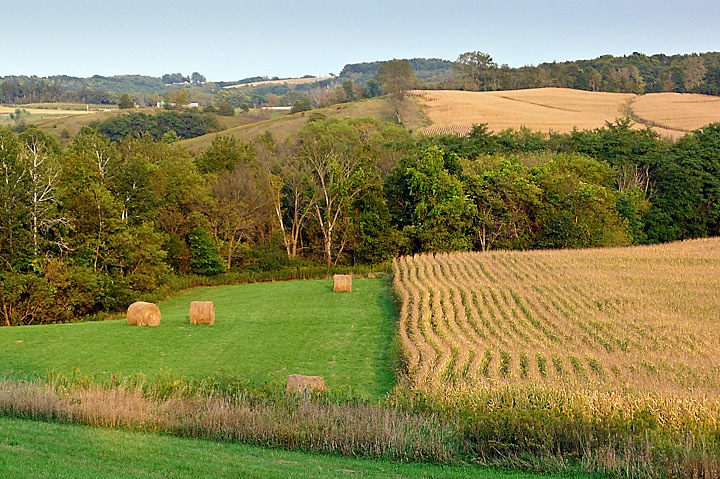
We have been very busy re-inventing here at the shop.
To begin with, we have been very focused on slowly
unveiling Red Wing
Digital. Red Wing Digital is a print-on-demand
product that provides unique large-format
presentation products, namely the
Panel Print and the
Acrylic Print. The Acrylic Print is slowly
getting ready for production, but it has taken longer
than hoped.
Secondly, we have a new business partner. Fine Art
Prints on Demand is a United Kingdom company.
This is a side of the business (printing and framing
fulfillment) we have been quietly working and growing
for a number of years. FAPoD is our third customer
for this side of the business.
These two developments have driven our third
initiative. We are moving our production to a larger
facility. We have narrowed our options down and
expect to be able to make some final decisions
shortly.
2011 Flyway Film Festival
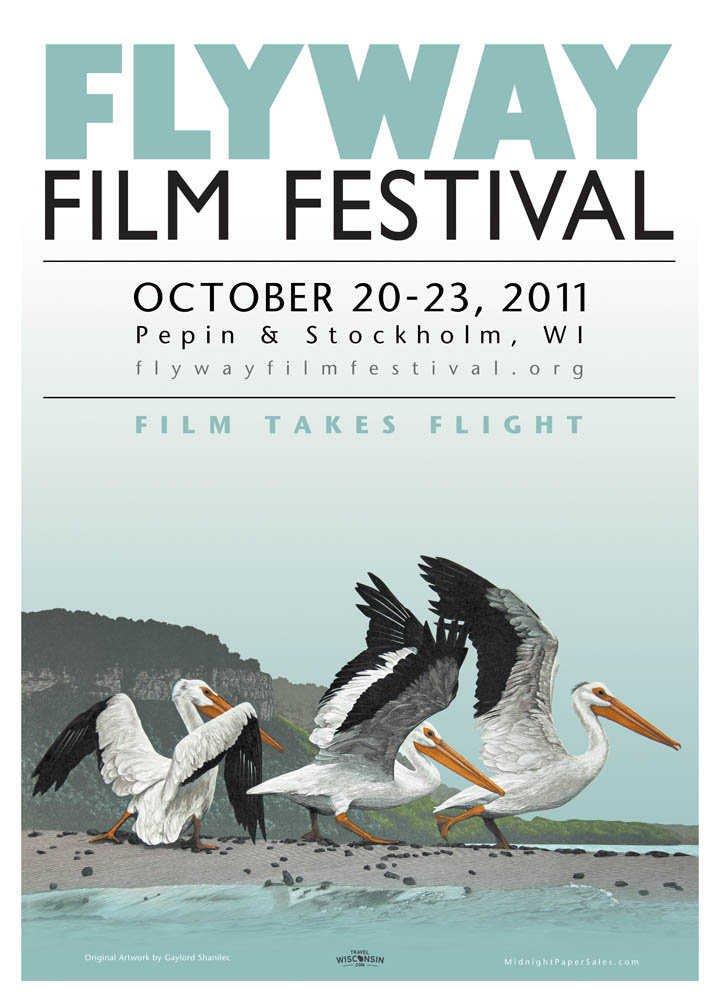
The
Flyway
Film Festival is one of our favorite events each
year. It is an uninhibited creative endeavor over
three days in October. Each year it has grown in size
and scale and this year promises to be especially
exciting.
First, the Flyway Film folks received a generous
grant from the Wisconsin Department of Tourism that
will really boost marketing efforts. This extra money
will be used to widen the circle of marketing.
Second, the festival graphic is noteworthy for the
artist. Gaylord Shanilec created the original etching
of the three pelicans that are used in the poster.
Gaylord is unquestionably talented, pelicans are
indigenous to this area and it is just an exceptional
image of this region. Totally appropriate.
And finally, a very limited edition of signed
fine-art are available for purchase, which will be
used to help fund the festival. We printed the
limited edition prints on a Hahnemuehle textured 100%
cotton paper that should last for hundreds of years.
October 23-25. Can't wait.
2010 Flyway Film Festival
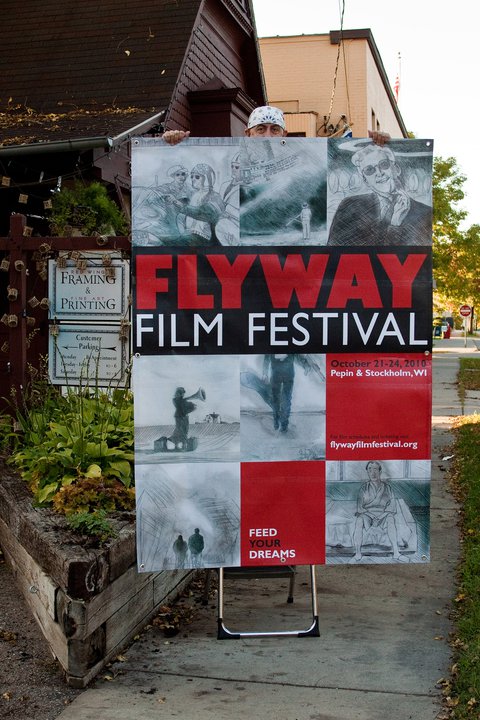
Once
again we are delighted to be a red carpet sponsor of
Flyway Film Festival. This event is in its third year
and is really beginning to collect some traction. The
quality of the movies this year is very impressive.
The Festival begins on Thursday, October 21 with a
gala event in which the sponsors, directors, actors
and organizers get together, nibble on snacks, drink
some wine and have creative discussions. At the end
of the evening there will be an awards ceremony.
The films begin on Friday, October 22 with the
screening of "Baraboo",
which sounds like a very interesting
film
about life and the hand we are dealt. Over the course
of the weekend, 21 films will be screened.
Details
are at www.FlywayFilmFestival.org.
See you in Stockholm in two weeks!
AmericanPoverty.com and Catholic Charities USA wrap-up...
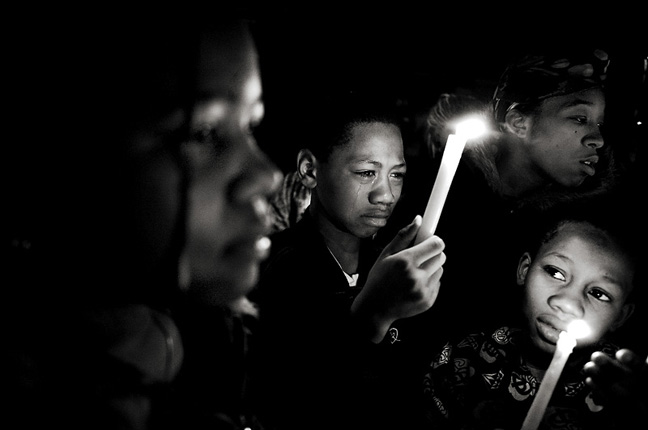
This
week marks the final chapter of the poverty awareness
photojournalism exhibit entitled "In our own
backyard". This exhibit has crisscrossed the United
States for the past 18 months and next week the
exhibit finishes in Washington DC at the annual
Leadership Summit for Catholic Charities.
Since this is the final and highest profile stop of
the tour, all of the large format images are being
reprinted and remounted, which is close to 120
images.
It is a very moving set of images, that address all
manners of poverty and everyday life. It is really
hard not to stop and soak up the texture and realism
of each image.
This has been a challenging and gratifying project.
One of the best parts of this project has been
working with Steve Liss. He is a natural-born
educator and an amazing photojournalist who gets
right into the thick of it. Please visit his web site
at: SteveLiss.com.
Time for a Max Becherer update...
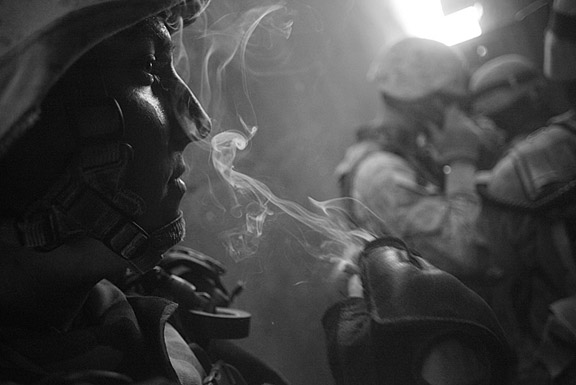
It
has 18 months since the last Max Becherer update.
Just to refresh, we came to know Max five years ago
when we hosted his photojournalism exhibit entitled
"Through the lens; Life in Iraq". Max has been in
Iraq since the very beginning of the conflict
(remember "shock and awe"?) and has seen action in
Iraq, Afghanistan, Pakistan and Gaza.
Max
has since gotten married and splits his time between
Cairo, Egypt and California when he isn't in the
field. He is still a combat photojournalist and he is
still extremely talented. Max's work has been
featured in Newsweek, Time, The New York Times, The
New Yorker, US News and World Report and Men's
Health.
Recently Newsweek Magazine asked Max to retrace the
Iraq invasion in reverse, using his photos. That
feature can be found
here.
After you visit that site, please visit Max's
website and
enjoy his talent. It is rare to see photography this
deep in the action.
Russell Patterson, 1893 - 1977
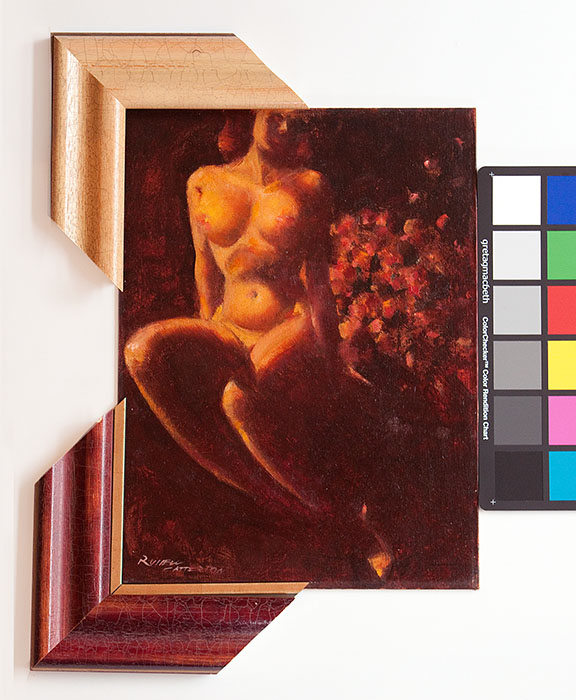
Half of the fun of framing (and it is very fun) is
researching the art. This was a piece that was
recently acquired in an art auction and this artist
merits the research.
The piece is entitled "Nude & Flowers" from 1964
and painted by Russell Patterson. It is 12"x16" and
it is an oil on hardboard.
Patterson
was a fascinating personality who lived from 1893 to
1977. He began his career as a magazine illustrator
working for Vogue, Vanity Fair, Cosmopolitan and
Redbook. During this period he achieved celebrity
status as an illustrator of beautiful women.
In the early 1930's he became restless and decided to
become a Broadway costume designer for several
successful Broadway productions. By the end of the
1930's he had moved to Hollywood to work on scene and
costume design.
Again he became restless and developed a comic strip
called 'Mamie', which became a Sunday syndicated
cartoon that ran for six years. The Mamie character
was glamorously portrayed, which leveraged his
artistic talent and his sense of fashion.
By the 1960's he reverted back to being a fine art
artist, but was not above exploiting his celebrity
status by being a judge for Miss America and Miss
Universe pageants and endorsing Medaglia D'Oro coffee
and Lord Calvert whiskey.
Patterson was a renaissance man who grew up in the
public eye. He enjoyed new challenges and he
especially enjoyed his high profile status in the
media.
Now the challenge becomes how to best frame this
original that does this artist justice.
Finally, a chance to use 'ubiquitous' in a sentence...
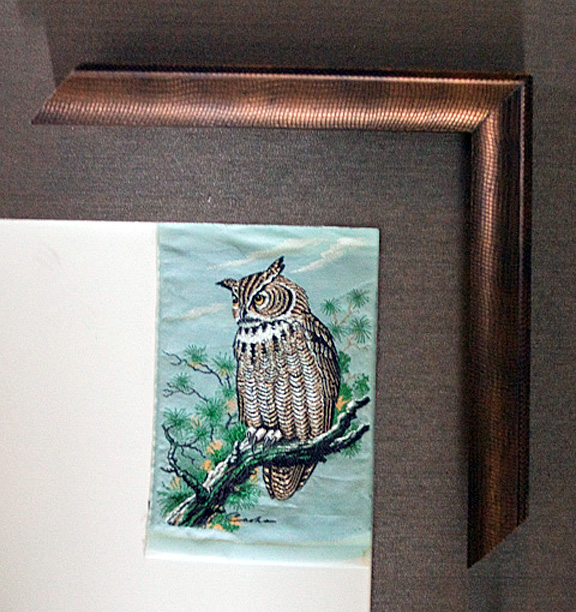
Cash's
(sometimes called J&J Cash) is a UK company
located in Coventry, England. Cash's has been
producing silk embroidered bookmarks, luggage and
clothing labels and name tags for over 150 years. You
might assume something as ubiquitous as a clothing
label would not merit museum level custom framing.
But you would be wrong.
Cash's produces a product that is clearly motivated
by quality and pride in craftsmanship. It is
genuinely a work of art, much in the same vein as a
beautifully machined watch. A labor of love, so to
speak.
This is a silk embroidered horned owl, which is part
of a limited run of coniferous forest animals Cash's
produced. Other varmints include a peregrine falcon,
an otter and some wood ducks. Each piece is about the
size of a business card and each will have their own
frame.
Cash's is currently producing a series of
Beatrix Potter silks, which is a perfect visual
for the embroidery medium. And the price is very,
very reasonable.
Richard Nixon, the everyman
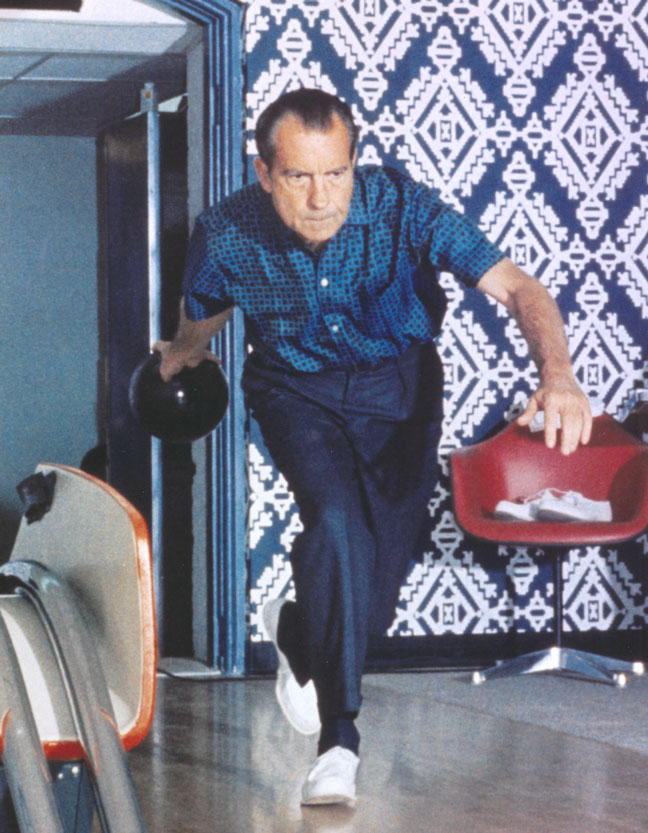
In
1969, friends of Richard Nixon paid for and had a two
lane bowling alley installed in the lower level of
the Executive Office Building. Nixon was an avid
bowler and spent quite a bit of time at this bowling
alley over the next five years. He had been known to
bowl up to twenty games without a break.
Ollie Atkins was the official White House
photographer and snapped this photo in 1970. Later
that year, Nixon's White House staff used this photo
to demonstrate that Nixon was not out of touch with
the average citizen, and in fact was just like any
other citizen.
It later achieved iconic status because of a single
scene from the 1998 film "The Big Lebowski".
There is a tremendous amount of public domain imagery
available from the US Government, some of it
noteworthy and historically significant. Some of it
kitschy. Since it was paid for with tax dollars, it
really is owned by the public.
Charley Harper, 1922-2007
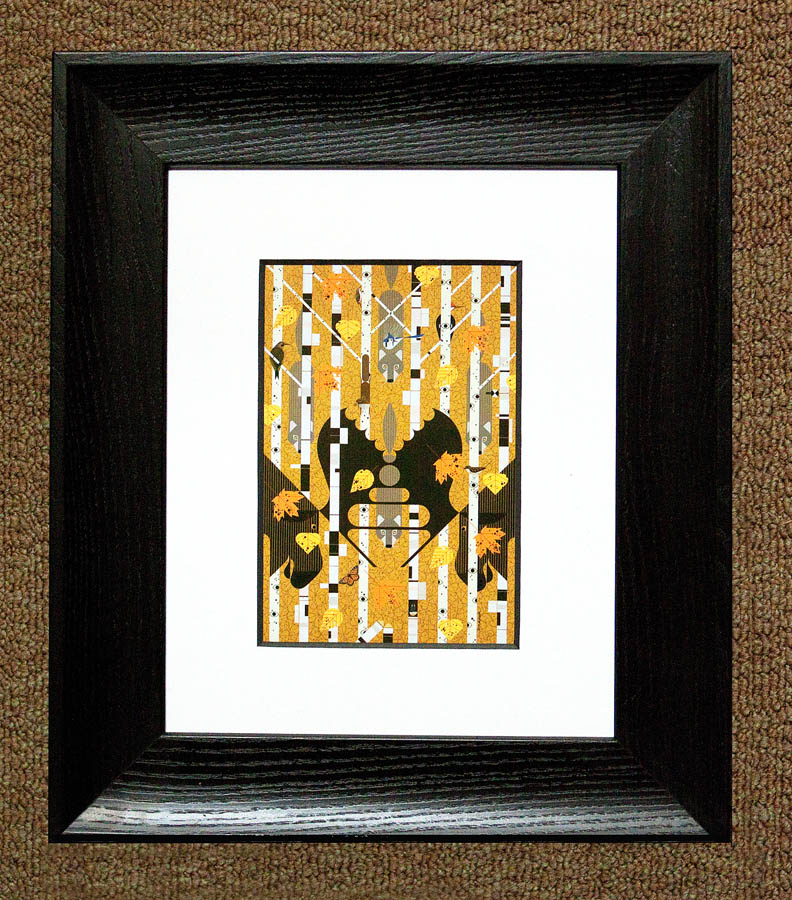
It was three years ago today that Charley Harper
died.
Charley was a very unassuming artist from Ohio. He
began his career as a book illustrator and over time
migrated to a wildlife artist. But not the typical
wildlife artist. Charley used his graphic art skills,
his penchant for precision and his sense of humor to
portray the natural world like no other artist ever
has.
This piece is called "Isle Royale" and incorporates
exactly what a birch tree forest feels like. You
might think you are alone, but there are probably
dozens of different eyes watching you at any given
moment.
Goodbye Charley. You are missed.
Bully Pulpit hiatus...
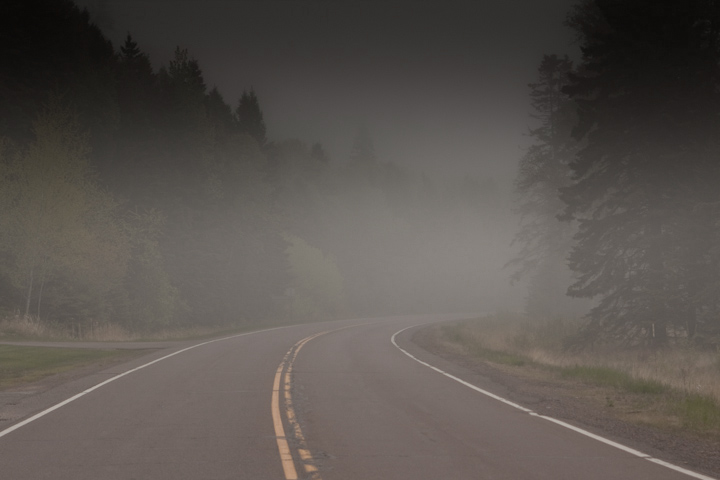
This note is being added after the fact. May was a
nearly overwhelming month between work, a
mini-vacation, graduations and non-profit activity.
In lieu of posting anything of substance, here is a
photo that was taken in May.
Grand Marias, MN on May 24, 2010. The fog was very
thick and the air was very gray. Probably not a good
idea to stand in the middle of the road, but it was
awesome.
Going ultra-wide
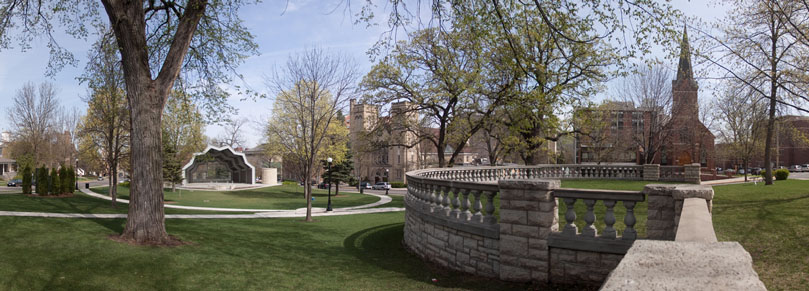
Because
the sensor in a digital SLR camera is typically
smaller than the 35 mm film that it replaced, the
physics of the focal point of the lens are changed.
This is known as "The Field of View Crop Factor" or
sometimes "The Focal Length Multiplier". The net
result means your long lens becomes longer and your
wide lens becomes narrower.
Wildlife photographers sing the praises of The Focal
Length Multiplier because their 200 mm telephoto lens
effectively becomes a 320 mm lens. Creative
photographers hate it because now a 24 mm lens
becomes a 38 mm lens and you can never get wide
enough.
My personal lens investment is from the pre-digital
era, so I never had the chance to compensate for this
effect. All of my lens became too long for many of my
purposes. I satisfy my need for wide by occasionally
renting a 14 mm ultra-wide lens (effective focal
length of 22 mm), which reminds me of the good old
days, when a wide lens was truly a wide lens.
Wide is a lot of fun and it also allows me to keep
the header imagery fresh.
Penumbra
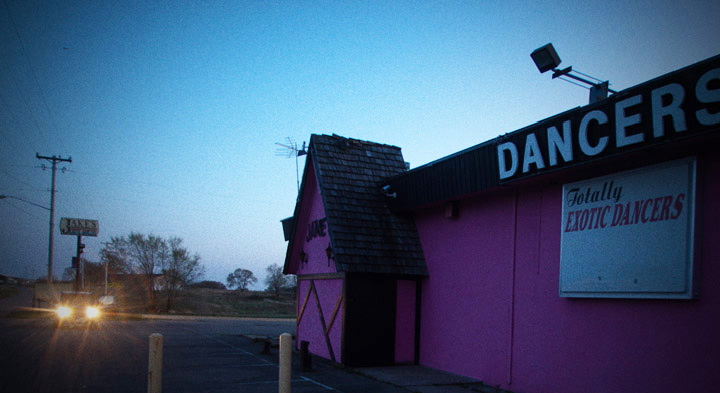
The definition of penumbra is 'almost shadow' or
'almost dark' (or light). Penumbra is typically used
to describe events in astronomy, such as when an
eclipse occurs.
In photography, penumbra is a unique opportunity to
capture texture and atmosphere in an almost
occult-like light. A strip club has always struck me
as kind of sad and desperate. I have been meaning to
take this photo for years but the highway has been
re-routed and it is especially tricky to get to. This
isn't exactly the effect I was looking for (drizzle
and water puddles would have been ideal), but I liked
the emotion the headlights provided.
Jake's strip club is located in Coates, Minnesota. It
had a litigious relationship with the community and
for years the town continually passed laws to close
it down. In 2002 the Minnesota Supreme Court ruled
finally that the town was within it's authority to
close Jake's. In an unwise effort to vote the local
politicians out of office, Jake's owner had 92
patrons (sometimes called rummy's) fill out voter
registration cards, using the strip club as their
home address.
You don't mess with the feds. It is never a good idea
to break federal voting fraud laws and especially in
such a stupid manner. Several hundred thousand
dollars later, the case was finally settled. The bar
never did reopen and it has been vacant ever since.
No doubt it will be torn down and the opportunity to
capture Jake's in penumbra light will be gone
forever.
The missing piece...
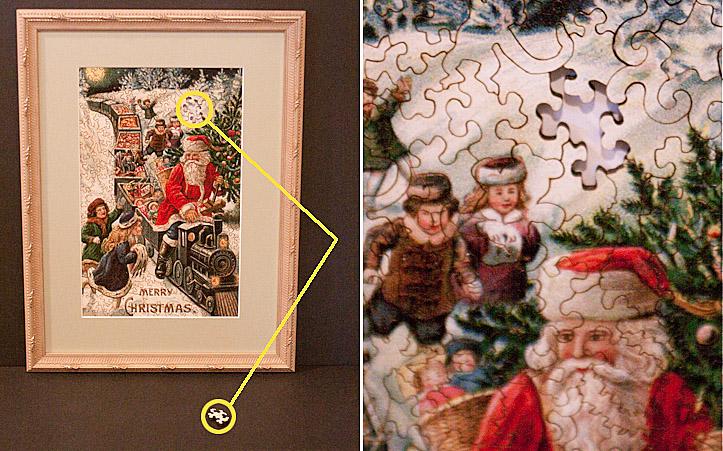
Many
years ago, a very good framing customer brought in
this beautiful antique jigsaw puzzle to be framed. It
was from the turn of the 19th century and the
construction itself is a work of art. The pieces are
scroll sawed and several pieces themselves are shaped
as children's toys (monkeys, toy soldiers, etc.). It
is a remarkable example of craftsmanship.
The
only problem was that a single piece of the puzzle
was missing. This seemed very tragic and because of
the depth of the puzzle, it was as obvious as a
missing tooth on a beautiful model in a toothpaste
ad. But, it is what it is, and since it had been in
her family for many, many years, it was decided to
frame it up regardless, as is.
Jump ahead several years to the present...the
customer removes a drawer from a dresser and
low-and-behold the missing puzzle piece reappears
from behind the drawer.
There is something very therapeutic in knowing that
the missing puzzle piece will soon be reunited with
its brothers and sisters and now the picture is
complete.
The Lord works in mysterious ways.
Yoshitomo Nara
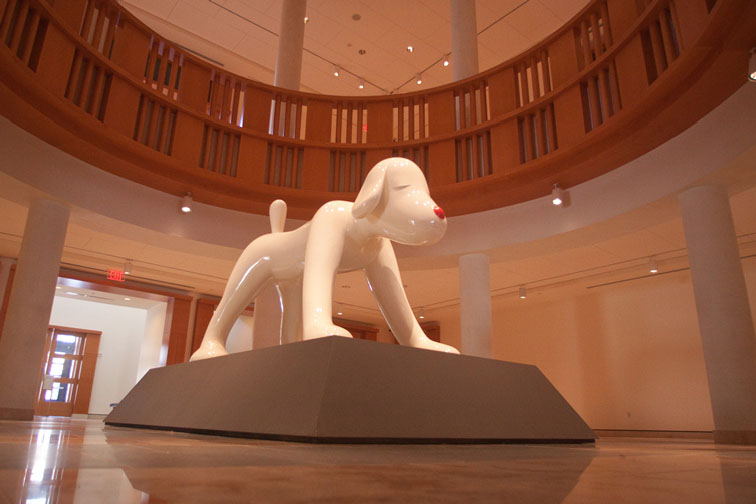
Yoshitomo Nara is a 51 year old Japanese pop artist
that has been influenced by anime and punk
rock. His sculptures seem cartoonish in nature
and are typically animals or children. Very
often his subjects will have contradictory elements
such as weapons or accusatory looks that belie their
wide-eyed expressions.
The
interesting thing about Nara is his
consistency. Artists like Nara have this
pursuit of the same relentless vision regardless of
the critics. Nara says he is helpless in this
matter because he is compelled to create
them.
This
fiberglass sculpture is called “Your Dog” and is part
of the permanent collection at the Minneapolis
Institute of Arts.
The traveling photojournalism exhibit

It
has been a full year since we became involved in the
Catholic Charities American Poverty photojournalism
project. It has been a rewarding and challenging year
and now a certain rhythm takes place as the exhibit
crisscrosses the United States. This coming week the
exhibit presents itself in Nashville, Tennessee. The
map above demonstrates where the exhibit has traveled
(in red) and where it is yet to travel (in blue).
Additional cites might still be added and no final
confirmation yet if the final exhibit will take place
at the White House.
Steve Liss is the Project Director and will travel to
each city immediately prior to the exhibit reception
and artfully and tastefully documents the slices of
poverty unique to each community. Our job becomes
image preparation (printing, mounting and packaging)
all of the images for each exhibit and delivering
them directly to the exhibit venue. Usually there
isn't a single day to spare and thankfully UPS has
delivered each and every package on time and in
perfect condition. Ideally there would be a larger
buffer of time for production, but then, what would
be the challenge in that?
It is a challenge and from every challenge you hope
you learn and improve from the experience. The
official web
site is worth a visit. It is very well
done.
Put up or shut up!
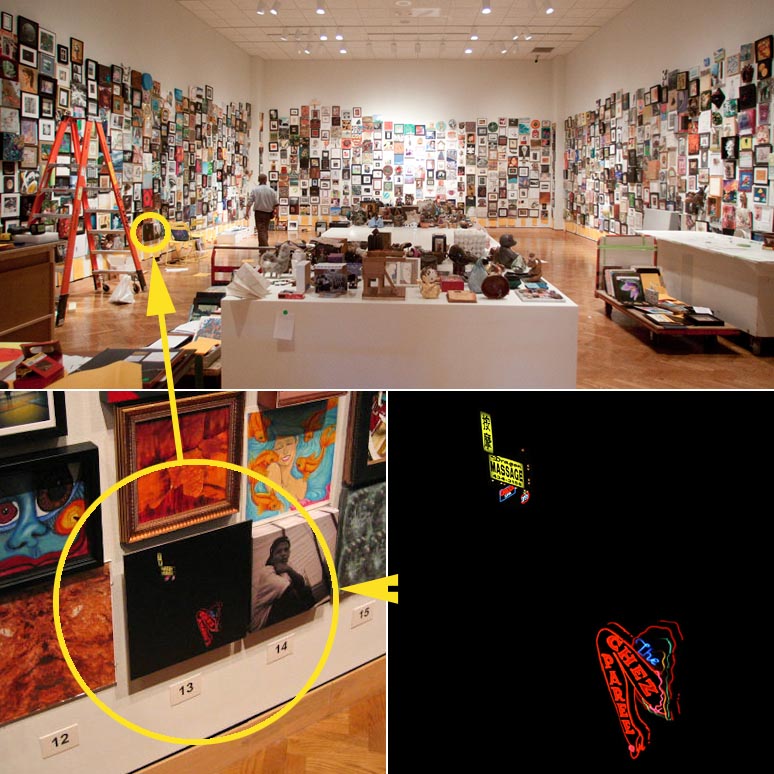
Over
the years and after working with countless artists,
it is easy to forget what an artist really goes
through when they exhibit their art. They open
themselves up for critical review and there is
significant exposure on the part of the artist. They
might be appear to be nonchalant or even
over-confident about exhibiting, but inside their
stomach acids are working overtime. For me, it was
time to put up or shut up.
The 'Foot in the Door' exhibit is different in this
regard. It is completely democratic, because if it
fits in the box, it exhibits. Consequently, it
becomes much less about the art and more about just
being able to exhibit and have fun. I submitted a
photograph I took ten years ago. it is entitled
"Midnight on Mason Street". It was taken in San
Francisco and the image exposure was on the neon leg.
This severely underexposed the rest of the image and
you are left with these two illuminated signs on
opposite sides of the street. It is a gimmick photo,
but I am partial to gimmicks. I was raised on comic
books and my favorite part was always the
Johnson-Smith page on the inside back cover (x-ray
glasses and such). The clearinghouse of gimmicks.
My favorite image from the exhibit has to be the seed
art tribute to wrestler Baron von Raschke. Classic.
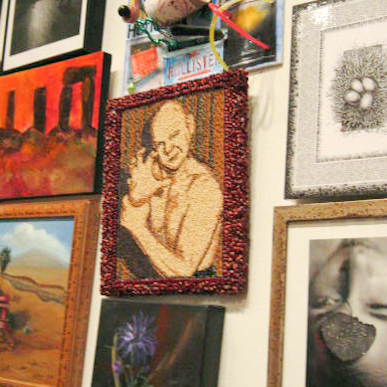
The story arc of the Marc Chagall project continues...
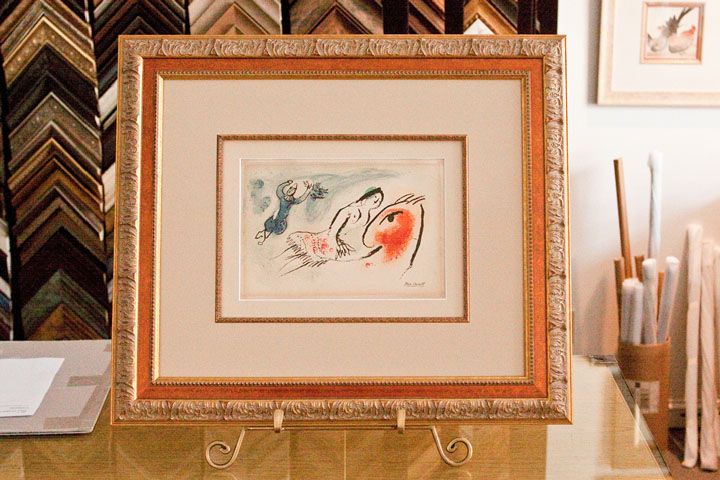
Just to refresh...a customer had rescued this
original Marc Chagall linoleum lithograph from slowly
being destroyed by the mounting and the framing
(please see:
"How to commit art murder", or, "I ruined a
masterpiece, but saved on the framing"...). The
mats were leeching acid into the art paper, the
non-UV glass was allowing the sun to fade the art and
the mdf frame was slowly dissolving the art with
formaldehyde out-gassing.
The rescued piece will be picked up by the customer
today and some type of ceremony will take place to
present the art back to the public library. I thought
I would share the design details of this project:
It is a double rag mat design (100% acid free) with a
filet. The bottom mat is a 1" reveal (this is a
museum standard for a design with a filet) and the
top mat is a 3.25" reveal. The art paper had some
waviness and it is loosely held in place with
archival corners on the backside. This allows the art
to breathe and respond to the ambient temperature.
The outside moulding is called an Amante design and
is a classic moulding style. The glazing is a museum
quality UV glass, which is almost imperceptible. It
was decided not to conceal the staining from the
previous mats and try to work the flawed feature into
the overall design.
It looks very classy and is totally reversible for
future framers in the event of a re-design.
Respect the art. Protect, preserve and present the
art.
More about 'Foot in the Door 4'
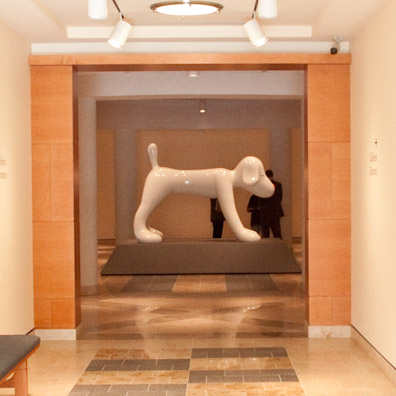
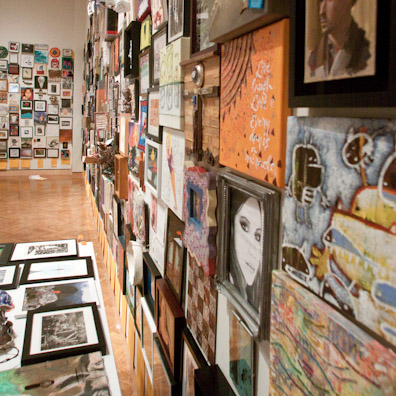
I
love the Minneapolis Institute of Arts. I know that
is not a profound observation for anybody who has
ever visited the MIA, because anybody who has ever
visited it, also falls in love with it. It is a
friendly and welcoming arts atmosphere (which isn't
as common as you would hope), the art is terrific and
it is free. What's not to love?
Be that as it may, the 'Foot in the Door 4' is
shaping up nicely. I had the chance to visit a second
time before the public unveiling. The total
submissions were beyond all estimates and the lines
were long for nearly the entire four day submission
period. The final number is a closely guarded secret
until the public reception, but sources close to the
count have provided a range of between 4,700 and
5,000 entries (compared to 1,700 submissions ten
years ago, the last time this exhibit took place).
Three large gallery rooms will be filled and the raw
expression of creativity is almost overwhelming.
I managed to find my piece and two of the three
pieces I had submitted on behalf of friends and
offspring. It looked as if about half the art was up
and I did hear that all of the art had been
photographed for the online gallery.
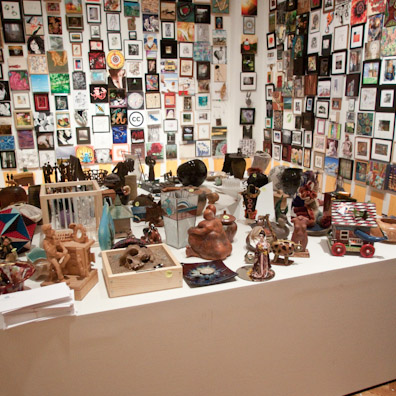
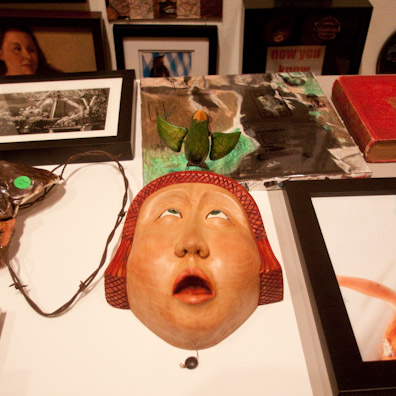
Behind the scenes of 'Foot in the Door 4'
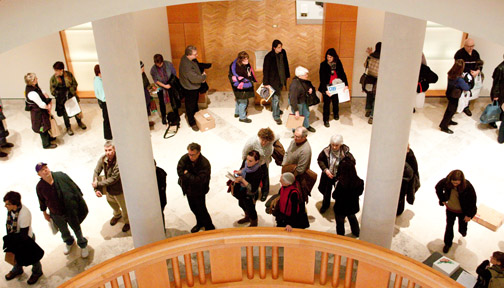
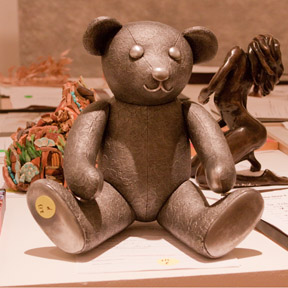
This
job provides for a couple of perks, one of which is
being involved in interesting art exhibit projects
from a 'behind the scenes' perspective. In other
words, friends in the art world ask you to volunteer
to help them with an event. Yesterday was a perfect
example.
Every 10 years (this being the fourth time), The
Minneapolis Institute of Arts hosts an event called
the "Foot in the Door" exhibit. Essentially, any
Minnesota resident, at no expense to themselves, can
submit one original piece of art they have created to
be exhibited at The Minneapolis Institute of Arts.
The art cannot be larger than 12"x12" for wall art or
larger than 12"x12"x12" for three dimensional art. It
is a terrific opportunity to exhibit in one of the
most prestigious museums in the world for four
months.
Art check-in takes place over four days. As a
volunteer for the art check-in, my responsibilities
were 1) insure the art did not violate the size rule,
2) collect the paperwork for each piece, 3) assign a
wall location, 4) provide a receipt for the art and
then 5) deliver the art to the staging area. In other
words, the first point of contact for the artists.
The art itself was impressive and the range was
amazing. Each piece was cradled by the artists as if
it were a newborn.
After the art is received, it is staged in an exhibit
room and waits to be registered in the computer and
photographed for the on-line catalogue. Over 1,000
artists checked in art the first day and over 3,000
submissions are expected. At the peak crowd size, the
wait was 2.5 hours, but everybody was extremely
patient and in a very good mood.
One of the other perks in volunteering is checking in
your own art (and your friend's art) without the
complication of waiting in line. Those will be posted
later.
Today my back is killing me (marble floors) and I am
exhausted. It cost me a day's pay to be there and the
tuna sandwich was stale when I finally had a chance
to eat. But I made many new friends and saw many
familiar friends and would do it again in a New York
minute. I can't wait for the exhibit reception which
is on February 18, 2010.
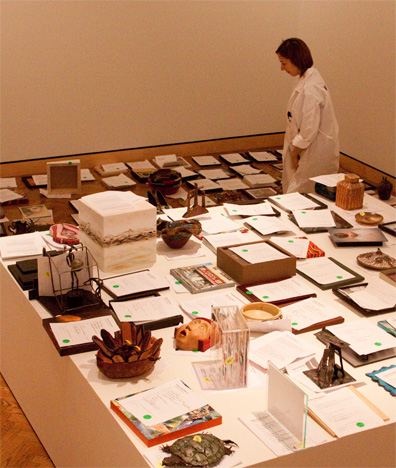
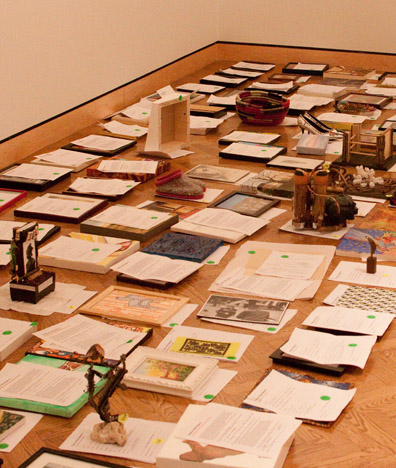
A good gig
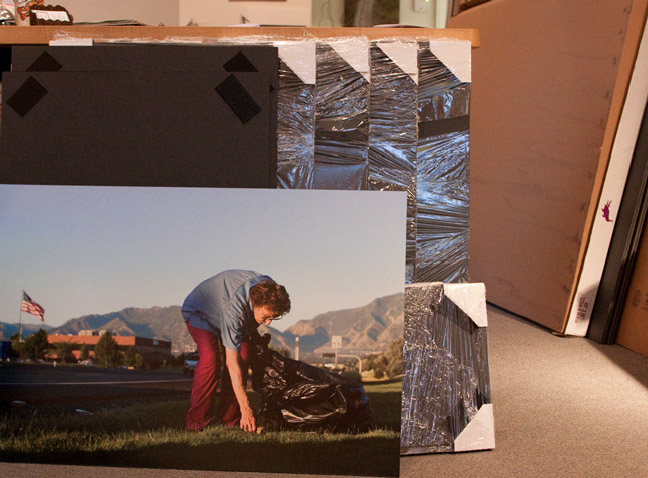
January
is usually a quiet month in the art and framing
industry. There might be a small bump in business
because of some Christmas follow-up framing, but that
trickles away pretty quickly.
This January was an exception. Several projects came
in the door because of fiscal calendar years that
started January 1st. Another major Catholic Charities
project was delivered, this time for a Centennial
Leadership Summit in San Jose, CA. This was the
largest venue so far (this being the 4th) and it will
move across the United States every month until
September, where hopefully it will exhibit at the
White House. Go to
www.AmericanPoverty.org to get the most current
updates. I love working on this project because it
leverages the power of photography and it is an
absolute adrenaline rush in meeting the tight
deadlines. In this business, this is known as a 'good
gig'.
We also had our first order from Turkmenistan. To be
more precise; Ashgabat, Turkmenistan. This is a
former Soviet Union republic that declared
independence in 1991. It was a nice sized order of 10
large format mounted images and one extremely large
canvas print. There is a sense of satisfaction in
knowing your handiwork is on the job in some remote
part of the world.
On an unrelated note; Downtown Mainstreet agreed to
co-sponsor a photography competition with Red Wing
Framing & Fine Art Printing. It is always fun to
have too much to do.
And finally, if nothing else I learned a long time
ago to surround yourself with very smart people. Or
at least stand close to them.
I am uber-excited about a new project that some very
smart people I have come to know are advising me on.
This is on a six-month timetable, so the details will
roll out over time.
How to commit art murder, or, "I ruined a masterpiece, but saved on the framing"...
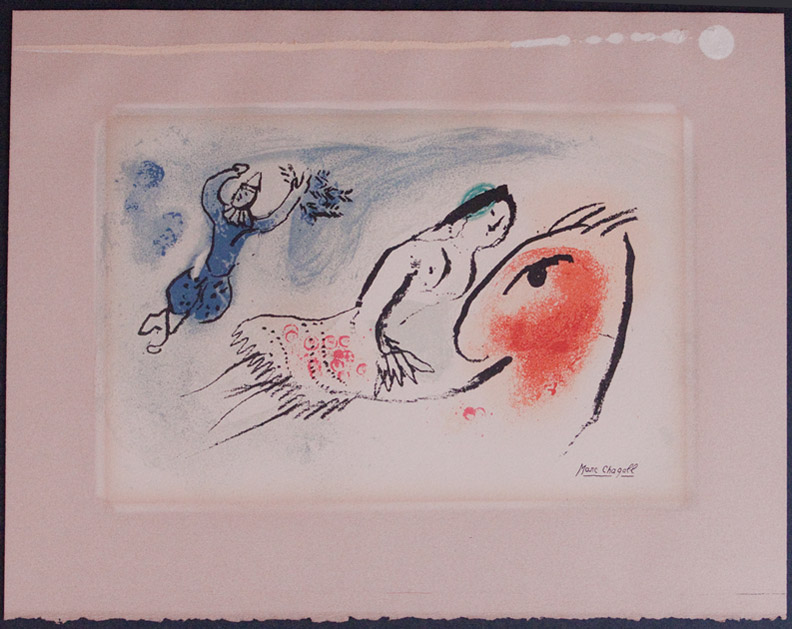

This
is very tragic, but thank God a good samaritan
rescued the art.
This original Marc Chagall lithograph had been
donated to the local library. Many years ago,
somebody made the decision to frame this
irreplaceable art with the cheapest framing solution
available. This included a cheap mdf frame with
standard glass and paper mats. To further insult the
art, the art was glued to the back of the mat.
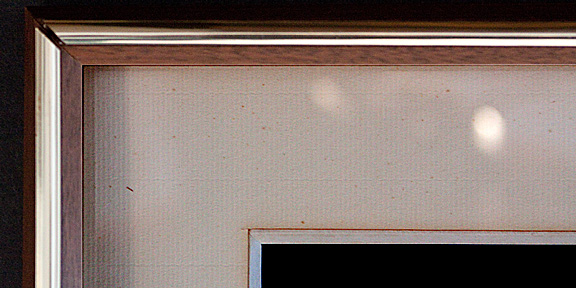
So,
let's summarize how this art was nearly ruined;
1) The frame was made from a cheap mdf material which
out-gasses formaldehyde (an effective way to dissolve
art),
2) The glass provided no UV radiation protection from
the sun so fading is inevitable,
3) The mat was a cheap paper mat with acids that
leeched into the art and foxing (bacteria) is growing
on the paper,
4) The glue. Sigh, don't even get me started about
the glue.
A biological, chemical and radioactive attack on the
art. A true WMD from an art standpoint.
Friends don't let friends frame drunk.
Be that as it may, it is an amazing piece of
creativity.
Chagall
was
a Jewish Russian-French artist who lived from 1887
until 1985. He was a giant in the art world and an
early innovator of Modernism. It really is inspiring
to examine.
We are working on a new and completely archival frame
design. I will post it when the project is
finished.
Ode to Element...
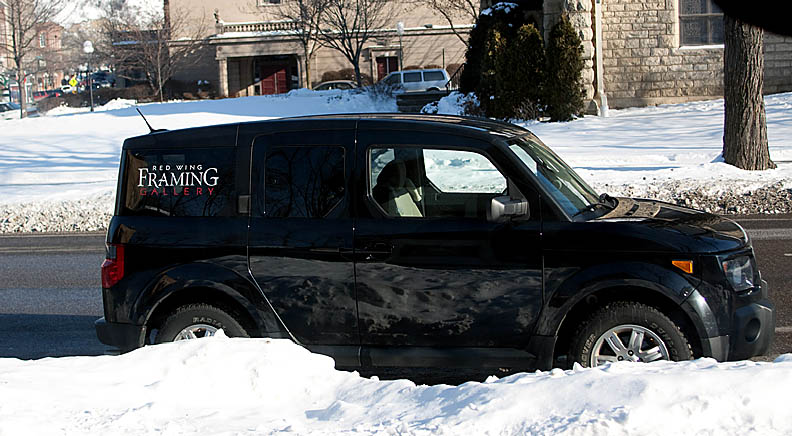
Admittedly
it might seem odd to write a haiku to a vehicle, but
I feel I owe it at least that, especially since I am
about 2,000 miles behind my scheduled oil change.
The 2006 Honda Element has been a beast for me (in a
good way). It is the perfect art transport vehicle.
Once the rear seats are removed, there is almost 73
cubic feet of very rectangular space, which is
perfect for hauling art upright. It is very
dependable and practical. On the downside, it is a
bit cold blooded and the passenger ride is somewhat
upright.
So, in lieu of an oil change (maybe next week) and in
the tradition of 5-7-5 haiku rhythm:
Ode
to Element
A square can roll round
Even in Winter
Happy
new year!
Next stop: The Newseum
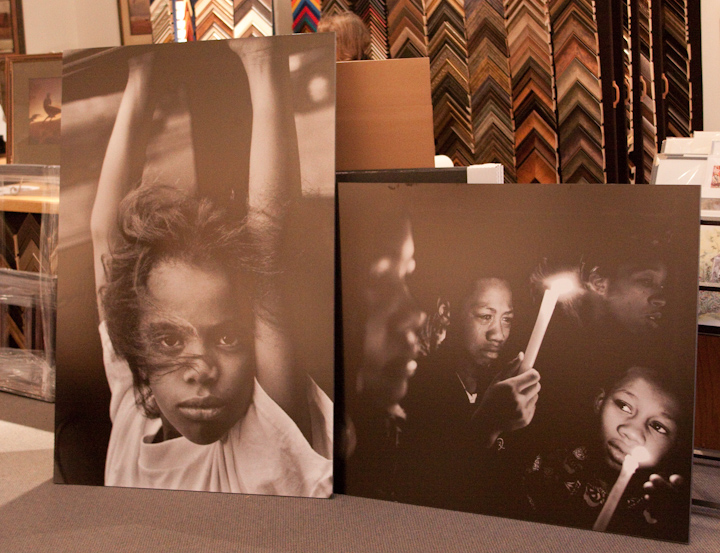
The Newseum is
an interactive museum of news and journalism in
Washington D.C. The mission of The Newseum (from
their web site) is to "educate the public about the
value of a free press in a free society and tells the
stories of the world's important events in unique and
engaging ways". In other words, it is all about the
First Amendment. It is located just off Pennsylvania
Avenue near The U.S. Capital. This is a high profile
location in a high profile city.
As part of our ongoing relationship with the
AmericanPoverty.org photojournalism
exhibit, we produced several very large (48”x72”)
mounted prints for a reception at the Newseum later
this week. The images needed to be large because the
reception hall is large and visual impact is
important. This is an exhibit designed to create
momentum for the AmericanPoverty.org campaign going
forward.
These images have this beautiful platinum print
finish. Platinum prints (sometimes called
platinotypes) is one of the oldest photographic
processing techniques and provides the greatest tonal
range of any printing method using wet chemistry
development. But because this is the digital age,
platinum prints are ‘replicated’ in the computer, yet
they do a terrific job of re-creating the original
look.
2010 will see an acceleration of activity with
Catholic Charities and AmericanPoverty.org.
And we can hardly wait.
Hard Boiled Art exhibit...
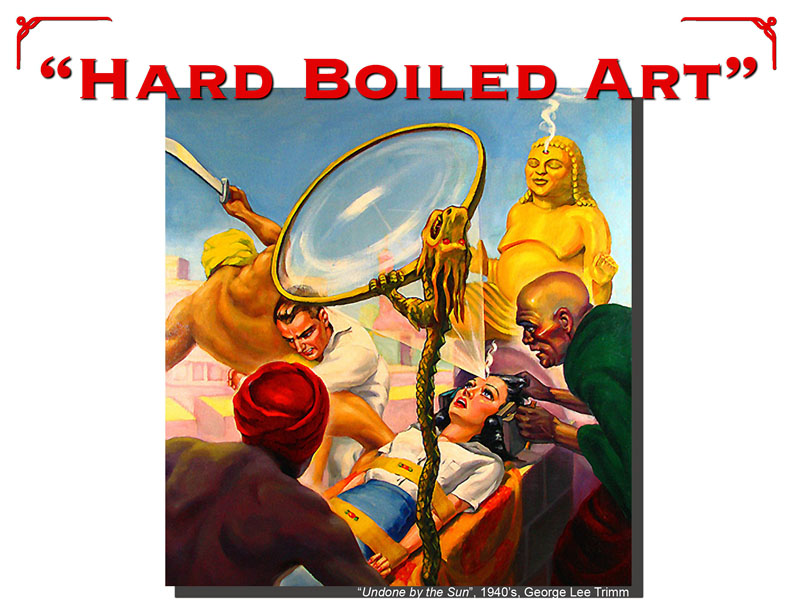
Details have been finalized for our next original art
exhibit. "Hard Boiled Art" presents original pulp
magazine cover art from the 1930's to the 1960's. The
exhibit will run from November 5th to December 6th,
2009 with a reception that is still to be determined.
This is a unique art form. Pulp magazine covers were
very sensational and were considered the most
important aspect in the sales of any particular pulp
series. The socially acceptable boundaries were often
tested and the topics reflected the then current
popular culture.
The covers were typically machismo in nature with
elements of evil or danger and at least one hero. The
1930's had strong detective and science-fiction
followings and the 1960's were all about the 'Red
Scare' of the communists.
Regardless of the threat, the damsels in distress
typically had a torn blouse. :)
Come and enjoy the exhibit. This is a rare
opportunity to see the original art that was used to
create the published covers. It is fun and an
absolute snapshot of an industry that hardly exists
any longer.
Flyway Film Festival countdown...
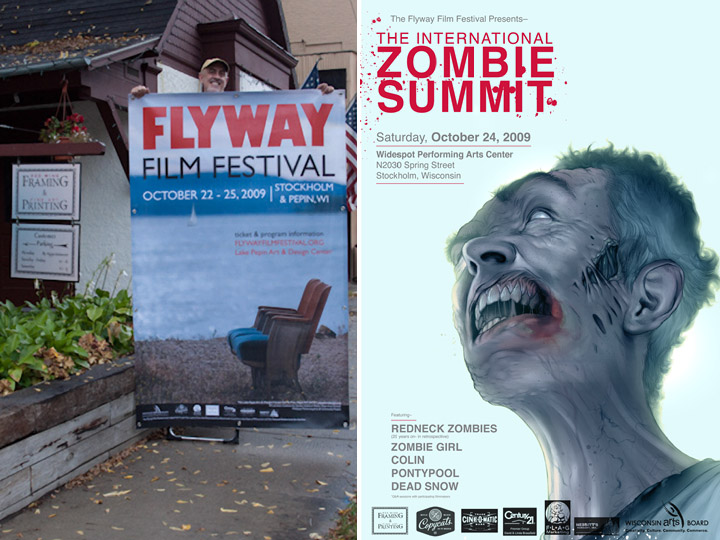
This
weekend is the much anticipated 2nd annual Flyway
Film Festival. The event begins on Thursday night
with a meet-and-greet reception and the opening night
of movies begins on Friday night with
"Storm",
followed by
"Ink". In
many cases both actors and the directors of the films
will be at the film festival to answer questions and
over the course of Friday, Saturday and Sunday over
30 independent films will be shown.
Saturday will be a bit different with a one-day,
genre-specific event of classic and cutting-edge
independent zombie films. And everybody loves a good
movie about the undead :)
We are proud to be a red carpet sponsor of this
ambitious art endeavor and to have provided the large
format graphics to promote this event.
Details are at www.FlywayFilmFestival.org.
See you in Stockholm this weekend!
Why don't you take a picture? It will last longer.
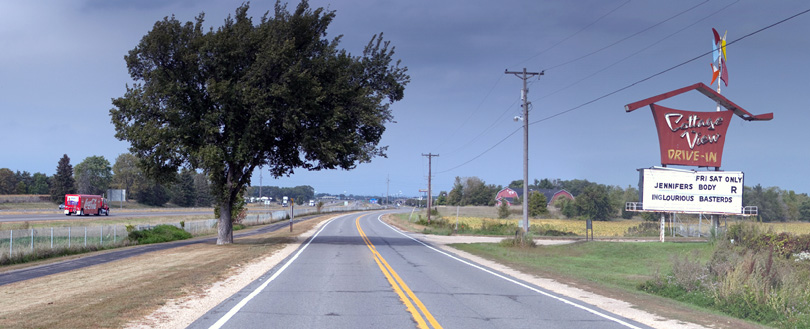
For the humor-deprived the title might seem
borderline inappropriate, but it actually is very
appropriate.
Photographers have a responsibility to document the
world as it is. So many icons of our existence are
disappearing and once they are gone, they are gone
forever. A drive-in movie theater only lasts as long
as the economics of local development allow it to.
Once the land becomes more valuable as anything other
than a drive-in, adios drive-in movie theater.
Pay attention to everything and take nothing for
granted. Don't tell yourself that someday you will
take a certain photo. Take it today.
AmericanPoverty.org
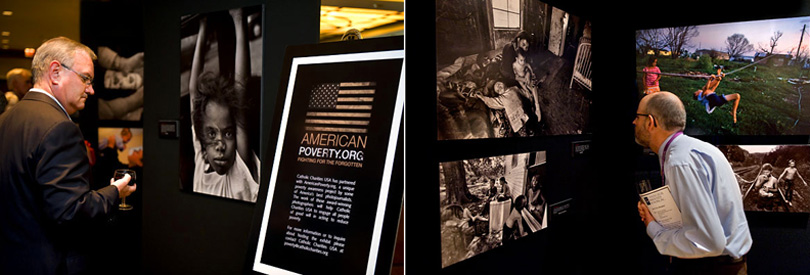
Last week Catholic Charities USA kicked off their
annual conference in Portland, Oregon with the large
format photojournalism exhibit produced by the
In Our Own Backyard photojournalism
team.
This
exhibit was entitled AmericanPoverty.org
and is meant to raise the awareness of people living
in poverty in the United States. Catholic Charities
has declared the goal to reduce poverty in the United
States by 50 percent by the year 2020. This is a very
aggressive goal, but Catholic Charities understands
that the only way to meet an aggressive goal is to
set the bar very high.
In
Our Own Backyard is
a team of skilled and seasoned
photojournalists who
have witnessed first-hand the struggles of extreme
poverty in the United States. This team includes, in
part, Steve Liss, Jon Lowenstein, Brenda Ann
Kenneally and Eli Reed. These are talented
photojournalists, with strong personalities and
stronger communication skills. They have crisscrossed
the United States in capturing exactly what it means
to be poor.
It has been a delight to be involved in this project.
The deadlines were tight and God bless overnight
delivery. There are a minimum of six more cities that
will be hosting this exhibit over the next year, so
we look forward to future involvement. Learn more
about this large format photojournalism project at
AmericanPoverty.org.
Jon Hassler paintings...
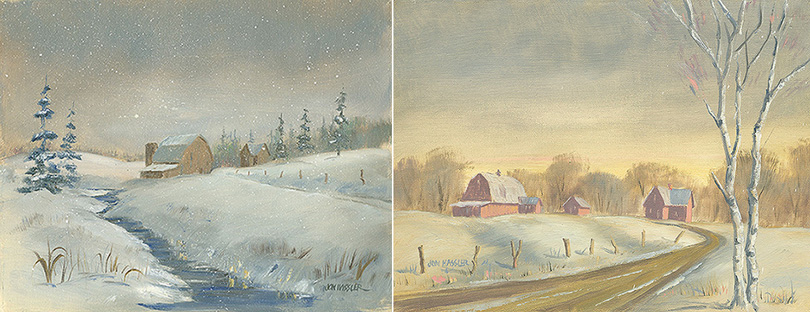
It
has been 18 months since Jon Hassler died. Jon was
well known for his literary skills, but many people
are not aware that Jon was an artist before he was a
novelist. He would teach English during the school
year (high school and college) and during the summer
he was on the art fair circuit. He began writing
relatively late in life (Staggerford was published
when he was 44), but he always enjoyed painting
whenever he had the chance.
Just like his books, his paintings have reoccurring
themes; rural landscapes, long light, complex skies
and almost always a strong vanishing point element.
In fact, they are almost exactly what you would
expect if you have read any of his novels or short
stories.
We came to know Jon five years before he died from
the complications of progressive supranuclear palsy.
Jon and his wife Gretchen entrusted us with 22 of his
original paintings (above left, 'Snowfall', 20"x16",
oil on canvas; above right, 'Road to Johnson's Farm
I', 16"x12", oil on canvas), all of which were
painted in the late 1980's. These are all remarkable
originals and a portion of each sale will be donated
to CurePSP (www.psp.org).
Flyway Film Festival sponsorship
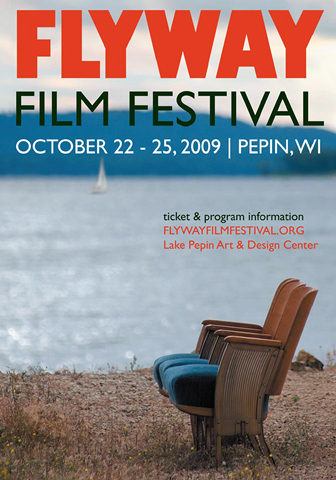
We are super excited.
This year Red Wing Framing & Fine Art Printing
will be a 'Red Carpet Sponsor' of the 2nd annual
Flyway Film Festival in Pepin, Wisconsin from October
22 to 25, 2009. The primary venue will be the Lake
Pepin Art & Design Center. Besides providing
support in part for the entire event, we will be the
presenting sponsor for the opening night events on
Friday night, October 23rd at 7 pm.
This is a significant investment for our modest
operation, but it makes sense for several reasons;
1) We like what this group is trying to accomplish
and their ambitious way of going about it.
2) We love films, which should be apparent by past
entries regarding the Chief Theater in Red Wing.
3) We feel it is very important to contribute to the
community and we like art venues that try to be
all-inclusive.
More about this as the calendar gets closer to the
the film festival.
Certified Picture Framer (CPF)
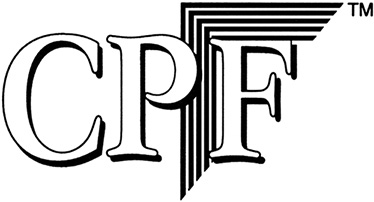
A
Certified Picture Framer (CPF) is a designation
administerd by the Professional Picture Framing
Association (PPFA). The PPFA adminsters the five hour
CPF exam twice a year and tests in the areas of: (1)
art and framing preservation, (2) framing knowledge,
(3) the mechanics of framing, (4) the mathematics of
framing and (5) art and image mounting.
To insure that any framer who has a CPF stays current
in the professional framing field, a CPF must retake
the exam and re-certifiy as a CPF every five years.
This is a very arduous and rigorous process, which is
why very few framers bother becoming CPF's. Red Wing
Framing Gallery is one of only five CPF's actively
working in Minnesota.
We are very proud of the professionalism in which we
address our business and we take our industry very
seriously.
This should be important to any client if their art
is important to them.
Pulp cover art...
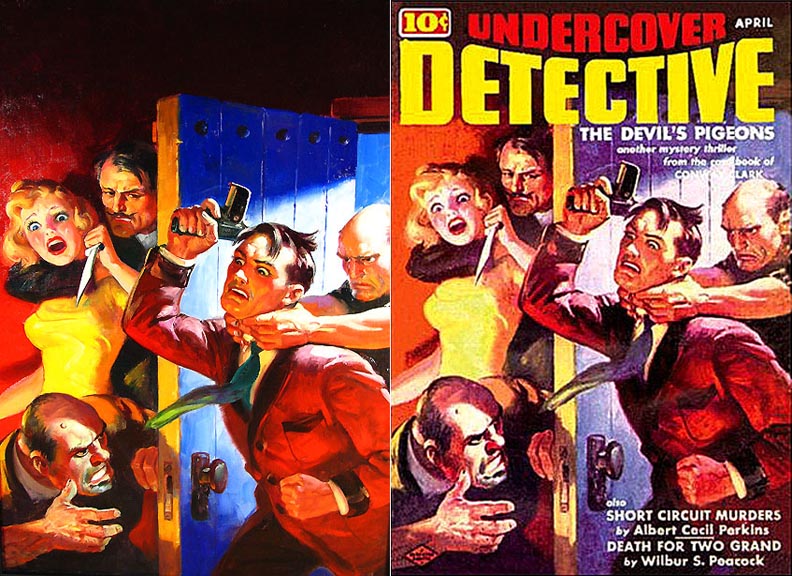
Pulp cover art has a unique place in art history. It
has terrific nostalgia appeal for anybody who enjoyed
The Hardy Boys, comic books or even a peek at The Old
Man's collection of True Detective or Stag magazines.
It had the specific purposes to grab your attention
on the newstand in a crowded field of competitor's
and to evoke an emotion, usually with a provocative
image of impending peril or suggestive sensuality.
Common elements usually include a couple of 'toughs',
a large breasted woman and a 'citizen' or a 'hero'.
The above example (original on the left, Rudolph
Zirn, 1939) has all three.
We are excited and delighted to announce a gallery
exhibit of original pulp cover art. The show will
open in October (date tbd) and will include both the
original art and the subsequent ephemera the
originals were used to produce. The colors are
extremely vivid and the techniques used by the
artists to project a response is fascinating.
This is the third year in a row that we have had the
pleasure of working with Grapefruit
Moon Gallery in presenting their collection of
illustration art. In 2007 we presented original
pin-up art (here
and
here) and in 2008 we presented original
Cream of Wheat advertising art. Pulp magazine art
is yet another sub-genre of illustration art that we
are proud to present.
The 'pulps' were fiction magazines that were very
popular from about 1930 to 1960. The term 'pulp'
comes from the cheap paper typically used in
production (cheap paper has a lot of wood pulp). The
magazines became noteworthy for their provocative
covers. The covers became so important that in many
cases the covers were designed first and the text was
designed around the covers. Pulp magazines were also
a major employer of short story authors and the
subsequent demise of the pulp industry created a
vacuum for these authors that has never been filled.
Oil or gouche paintings are used to create the
original cover art. The colors are intentionally
vivid to compensate for the primitive printing
technology at the time. Several pulp cover artists
(i.e., Frank Paul and Margaret Brundage) became
accomplished artists in this genre and attracted a
following. Pulp art has recently experienced a
renaissance in popularity and is widely sought by
collectors.
More details as they evolve but I thought this teaser
would have value.
Art for hire...
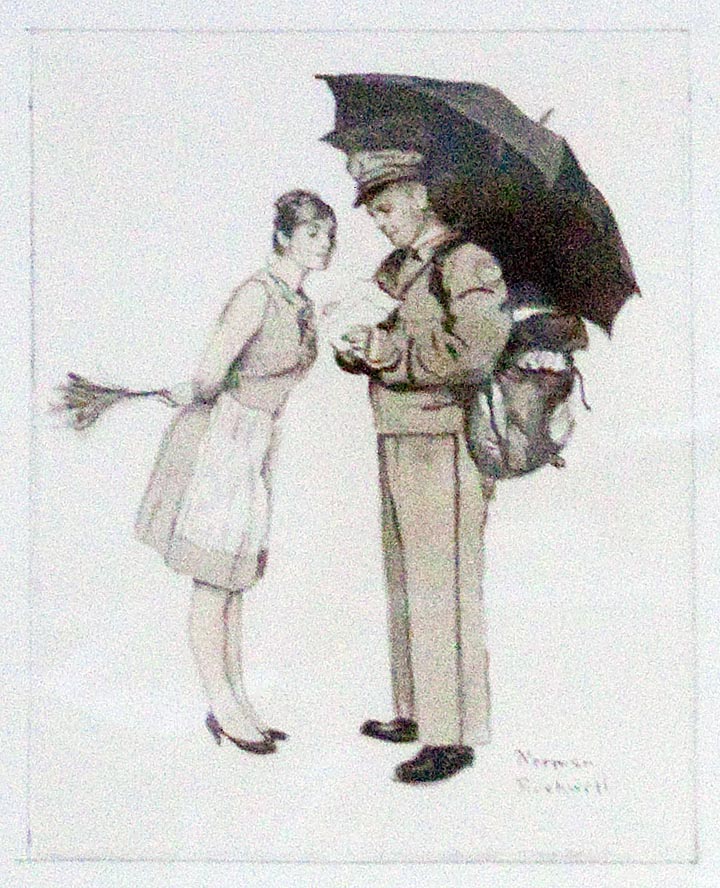
Recently
this Norman Rockwell concept sketch was in the shop
to be re-framed. Rockwell would rough sketch a
proposed painting, present it to a potential client
and solicit feedback. Hopefully he would be awarded
the project, finish the piece, get paid and then move
unto the next project.
Does the fact that an artist is directed what to
paint diminish the art itself? Not at all. Artists
who can support themselves strictly on their own
creative output are rare. And it is a minor step from
an artist taking on a commissioned project to a
full-time commercial illustrator. The net result
might not be an artist's first choice, but finding
opportunity to be creative within the boundaries of a
client's expectations requires both a unique skill
set and maturity as an artist.
This is the segue into an upcoming exhibit that was
just finalized this week. The working title (and it
will change soon) is "Tough Guys and Tough Cookies"
and will be a presentation of original art used for
pulp magazine covers. This art typically presents
scenes of over-the-top drama, usually with somebody
in peril. It is a sub-genre illustration art that
required efficiency and productivity on the part of
the artists. The pay checks were smaller than most of
their colleagues, but it paid the bills and allowed
artists to create art for a living.
This is the third year in a row we have had the
pleasure of working with Grapefruit Moon Gallery. The
first two shows (original pin-up art and original
Cream of Wheat art) were very successful. This will
be a bit different, but consistent with the idea of
presenting 20th century illustration art and various
subsets. More details next week.
The final chapter of the Central Park Bandshell being built
Promptly at 3:30 the ceremonies began, which was the official opening of the Bandshell. The Jones Family Foundation was thanked for their generous donation to the City of Red Wing. This really is an amazing gift; this is akin to having a second Sheldon Theatre, except it is an outdoor venue.
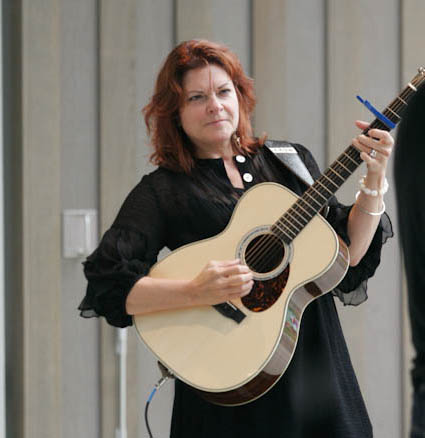
Several
Fiddler on the Roof selections were sung (a teaser
for an upcoming production) and Rosanne Cash and her
husband came out and performed for about 90 minutes.
It was a straightforward performance, very
professional and simple (two guitars). Just a class
act. Then Roomful of Blues picked up the tempo for
the next 90 minutes. The skies cleared (it was
spitting rain on occasion) and the Sheldon Brass Band
took the stage and played mostly some traditional
John Philip Sousa music.
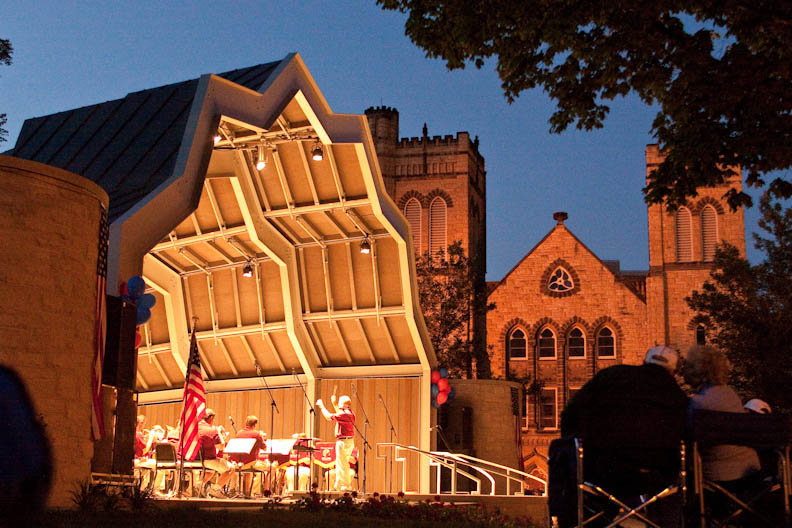
It was the final score, which was Tchaikovsky's 1812
Overture, that something truly remarkable happened.
Right at the crescendo, right at the peak of the
music, cannons began firing off explosions and all
the church bells in town started ringing. Red Wing
has a lot of church bells and between the Brass Band,
the cannons and the church bells, it was a very
moving experience. Several people started
spontaneously crying and it is hard not to get choked
up thinking about it now. The Sheldon Theatre
deserves a ton of credit for making this an amazing
day in Red Wing history.
It has been fun charting the progress of the newest
neighbor in our neighborhood. But now it is time to
move on to other curious topics.
Central Park Bandshell T - 3 days
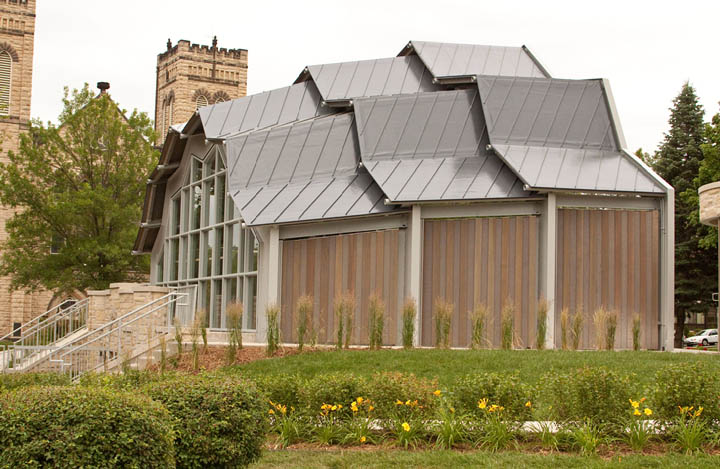
The
Red Wing Central Park Bandshell appears to be ~99%
complete. The railings need to be anchored and the
grass needs to be mowed one more time. It seems
right-sized for the park; not too big and not too
small.
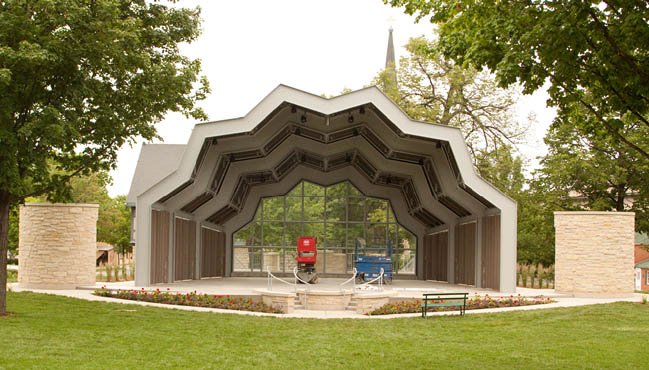
The
side walls (six total) all pivot open when needed.
The inside ceiling has a complete lighting system. It
isn't clear what purpose the two round towers to each
side serve. They each have doors as well, and when
opened close the gap between the towers and the
shell. It might be both dressing rooms and off-stage
space. One of the very interesting aspects of this
location is that in every direction a church steeple
can be seen.
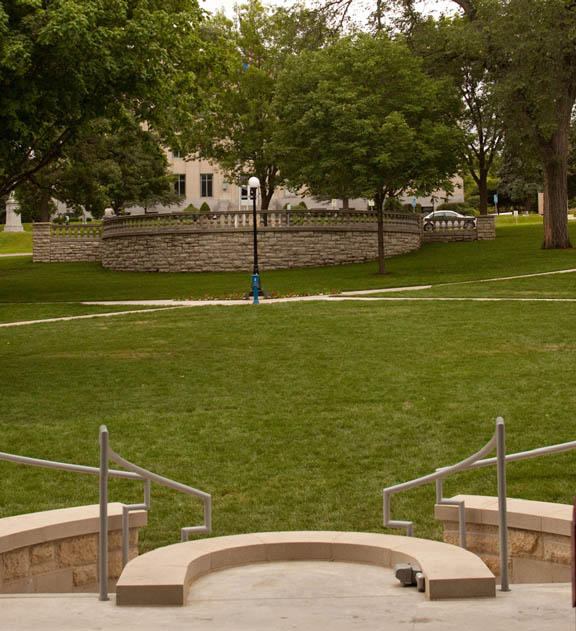
This
is the view from the bandshell looking out. The
balustrade wall was built in 1880 when Hamline
University owned this land.

Even the view behind the Bandshell is impressive. The activities begin on July 4th at 3 pm, The Sheldon Phoenix Theatre, Rosanne Cash, Roomful of Blues, the Sheldon Brass Band at 9 pm (complete with cannon) followed by fireworks over the Mississippi River. Awesome.
Central Park Band shell T - 7 days

It
is a week before the Red Wing Central Park Band shell
grand opening and it looks like the project will
finish right on schedule. All of the landscaping is
in, the roof is finished and the walls are just
finishing up. Photos will be posted this week.
This photo is what the bandshell replaced. It
essentially was a semi-circular stage with no walls,
roof or sound (except those two primitive speakers on
each side). One feature that did carry over from the
old stage is the two small curved staircases in the
front.
"Green side up!" T - 12 days

88
degrees and humid, but dry.
The landscaping and sod arrived this morning and by
the end of the day all of the greenery should be
installed. In speaking with some of the
subcontractors, the project is slightly ahead of
schedule.
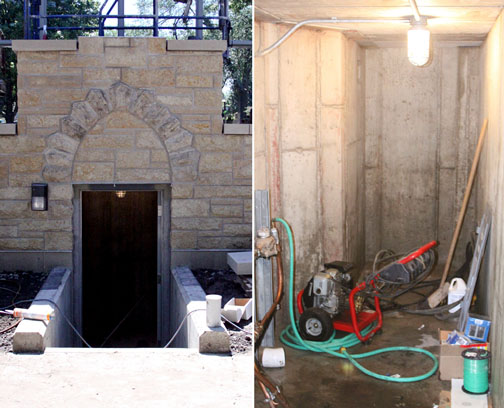
For
anybody who is curious about the mysterious little
back door; it leads into a vary narrow and small
utility room. The circuit breaker box and the water
meter are in this room. Kind of disappointing.
The walls arrive tomorrow (rumor has it).
Central Park Bandshell T - 17 days
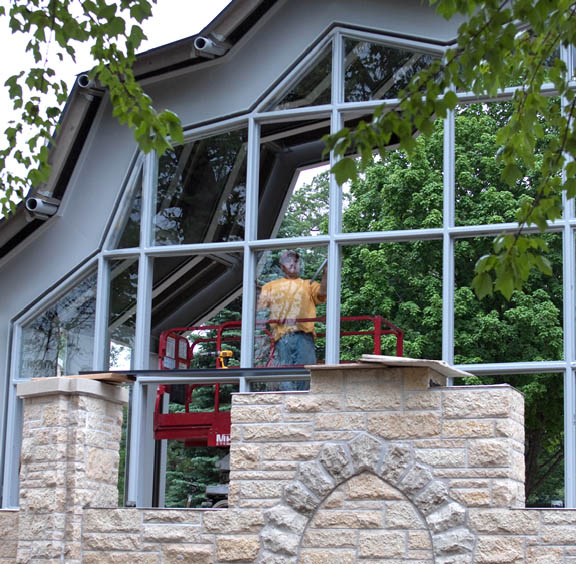
The
first of 32 - 1/2" laminated and tempered glass
windows were installed today in the back wall of the
shell. This promises to be one of the more striking
design elements of the Bandshell. It should really
open up the entire shell from both sides. The
limestone block is quarried in Winona, Minnesota and
each block is hand-cut. The pattern is random. The
keystone blocks are manufactured in a factory.
Rain is forecast for the rest of the week.
Central Park Bandshell T - 19 days

It is hard to tell if the Bandshell is ahead or
behind schedule. The irrigation system was installed
today and the handicap access ramp concrete was also
poured. Fill was being spread by the hard working
Sentence to Serve crew. Sentence to Serve are
nonviolent offenders that work on community
improvement projects. There are mixed feelings about
Sentence to Serve labor; on the one hand working
outside is better than killing time in a cell. On the
other hand it is an easy source of cheap labor for
communities that can become too easy to use.
The sod is scheduled to be laid on June 29, which
seems awfully close to the July 4th dedication. The
entire park (one city block) will be
re-sodded.
The ghost signs of Red Wing
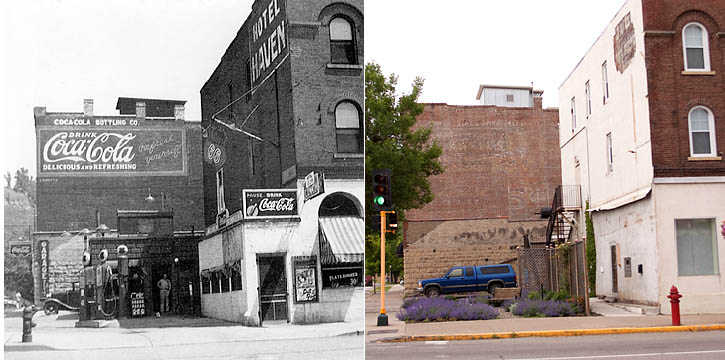
Red
Wing is unique because it has such an authentic core
downtown. This doesn't mean it is frozen in time.
Rather, it has more to do with having traceable
roots. Buildings are typically not torn down, and
when they can be salvaged and restored, they are.
One of the lasting elements that are easily
overlooked are the ghost signs of Red Wing. Sometimes
called fading ads or brick-ads, they are remarkable
in their staying power. Red Wing has many brick
buildings and there are several examples of ghost
signs all over town. You need to look close to see
the Coca-Cola ghost sign. The Hotel Haven sign is
pretty much illegible.
The above corner is Plum and East 3rd Street (SE
corner) in Downtown Red Wing.
The June update of the Central Park Bandshell

The Red Wing Central Park Bandshell continues to make
progress. The roof is on, but not yet shingled. The
foundation work seems to be complete, judging by the
dirt fill that was brought in. The back wall will be
glass and the shell walls will be the next
significant milestone.
The inauguration of the Bandshell will be on
Saturday, July 4th, 2009. The schedule of events are
as follows (all times are pm):
+ 3:45-4:30 The
Phoenix Theatre will sing selections from their
upcoming production of 'Fiddler on the Roof' (free!)
+ 5:00-6:00 Rosanne Cash
(free!)
+ 6:45-8:00 Roomful
of Blues (free!)
+ 8:45-9:30 Sheldon
Brass Band finishing with 1812 Overture, complete
with real cannon! (free!)
+ 10:00- ?? Fireworks over the Mississippi River
(free!)
Eat. Shop. Play. Local.

Recently
a letter to the editor of the local newspaper made
the argument for funding art at the elementary school
level. Apparently there has been discussion about
reducing the amount of art received in elementary
schools because of budget pressures. The typical
solution has been to increase the tax levy and ask
the tax payers to pay more.
A more sustainable approach is to simply spend local.
Every dollar spent locally in a community can have up
to three times the multiplier tax return to the
community versus buying from an out-of-state big box
retailer, all without raising taxes a single cent.
Let's use two simple examples:
Example 1) A citizen spends a dollar at a local
big-box retailer. Taxes are exchanged for that dollar
spent and the dollar is promptly deposited in an
out-of-state bank account somewhere in Four Corners,
Arkansas. That dollar is retired as far as the local
economy is concerned.
Example 2) A citizen spends a dollar at their local
custom frame shop. Again, taxes are exchanged but
this time the local frame shop owner races to their
local bank to cover the check they wrote to the local
plumber to have their hot water heater repaired. The
plumber in turn cashes that check to buy a silk suit
from Josephsons Clothing Store. Tom from Josephsons
then uses that money to buy himself a beer next door
at The Staghead Restaurant to celebrate having
finally sold that XXXL silk suit.
The same dollar has contributed to the local economy
three separate times, each time participating in the
overall tax exchange and actively contributes to the
cash flow of four different local employers.
Red Wing Downtown Main Street is focused on exactly
these types of issues. The Eat-Shop-Play-Local
tag-line could include many other action verbs (Buy.
Stay. Invest.), but the point is to think about where
your money goes after you spend it.
Visit the DTMS web site or
the
DTMS Facebook page and consider joining this
non-profit organization.
In Our Own Backyard follow-up...
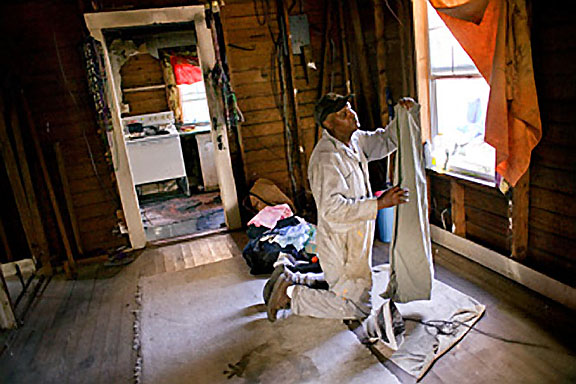
A little over a month ago, a
prototype of the 2009-2010 traveling exhibit of the
'In Our Own Backyard; U.S. Poverty in the 21st
Century' was unveiled at the College of St. Catherine
in St. Paul, Minnesota. This was an opportunity to
weigh the reaction and measure the effectiveness of
the message. Think of this as a preseason event
before the annual Catholic Charities USA convention
in Portland in September, 2009.
Things have not slowed down since then. Details have
been fine-tuned and the new web site can be
found
here. The tentative schedule for the
traveling exhibit is:
September 24-29: Portland, Oregon
October 29, 2009: Sacramento, CA
January 21, 2010: San Antonio, TX
February 24, 2010: Atlanta, GA
March 8, 2010: Albany, NY
March 25, 2010: Nashville, TN
April 22, 2010: Cleveland OH
April 29, 2010: Chicago, IL
Track the updates by following it on Facebook:
![]()
Johnny Cash's eldest daughter...
This is a big deal. A free concert at the new Central Park Bandshell by Rosanne Cash is a fantastic way to inaugurate this beautiful new venue.
If your musical tastes include country, folk, rock and the blues, then circle Saturday July 4, 2009 on your calendar. Go to www.RosanneCash.com for details.
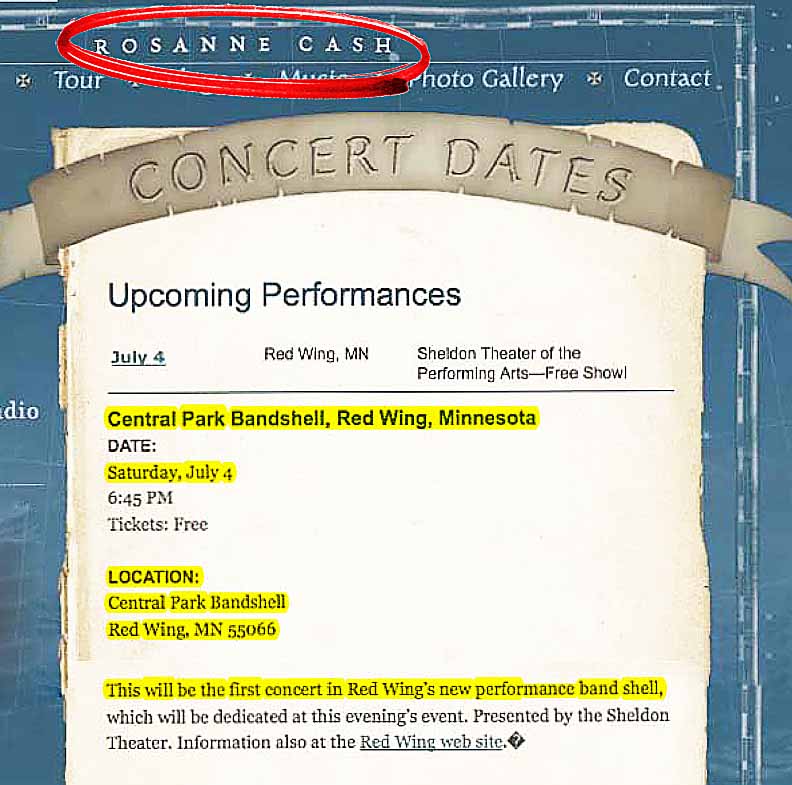
The Red Wing Framing Gallery Panel Print
And now, a word from the sponsor...
For years, people have been complaining that, "if they can put a man on the moon, why can't they put a print on a panel?"
Introducing the Red Wing Framing Gallery Panel Print.
It's a Panel! It's a Print!
It's a Panel Print!
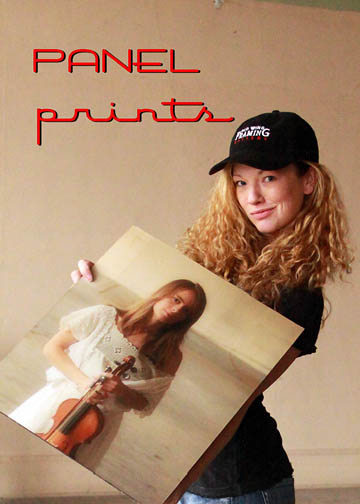
It begins with any digital photo
and ends with a full-print bleed, UV-protected, 1/4"
thick hardboard panel print that is
pool-table
flat and rugged!
The Panel Print has a linen laminate finish and a 1"
reverse frame mount. The mount lays flat on the wall
and the print is an elevated surface that creates a
modern 'drop-shadow' effect on the wall.
It can be printed at any size or aspect ratio (great
for panorama photographs) and it has been especially
popular with photographers who appreciate this very
contemporary look. It also works great for commercial
projects that are restricted from using glass or need
to cover large wall surfaces, yet still need to
project elegance and creativity.
Call the shop today at 1-651-385-0500 and create your
own art from your own images!
Now, back to the regularly scheduled programming.
Anatomy of an Exhibit
The entire exhibit process was documented, so if we let T = the actual exhibit time (4 pm, 04-20-2009), then T-x is some amount of time before the exhibit. Think of the television show '24', except instead of saving the country from terrorists with nuclear weapons, we are hanging art (the lamest metaphor to date on the entire internet).
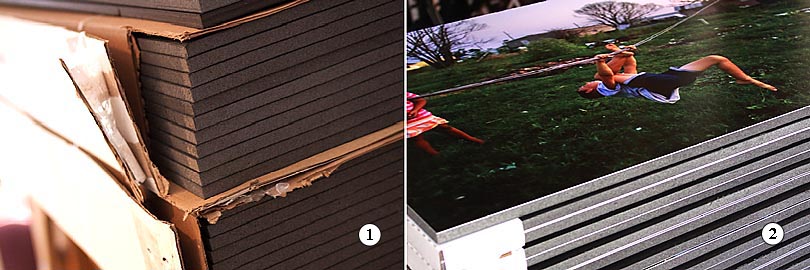
1)
T-2 weeks: Once the project is defined, the supply
chain of raw materials begins to fill up. This
exhibit required two cases of 4'x8'x1/2" black
Gatorboard.
2) T-1 week: Each image was printed on a premium
luster photo paper (a wide color gamut, scratch
resistant, but susceptible to fingerprints), vacuum
mounted to the Gatorboard and then trimmed to size
and packaged. 50 images were printed and mounted for
this exhibit.
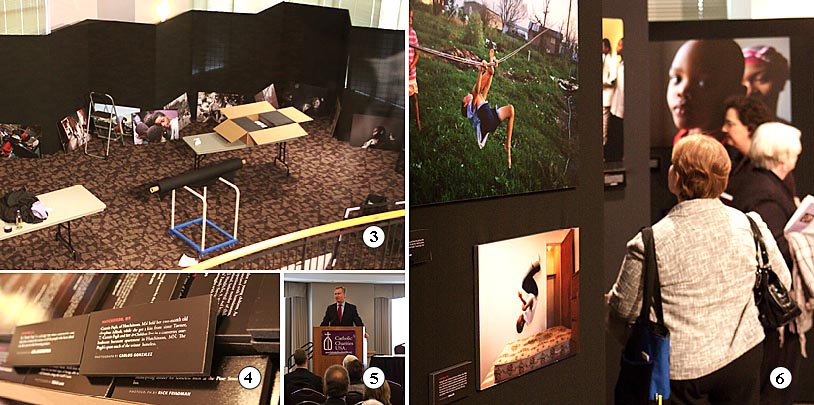
3)
T-24 hours: The finished materials were delivered the
day before the exhibit opening. The exhibit panels
were problematic for a few reasons, but the image
layout was deemed the most critical.
4) T-12 hours: The image title blocks completed the
story-lines. I was delighted to see that Carlos
Gonzales from the Minneapolis Star Tribune was
participating. I came to know Carlos from the Max
Becherer exhibit.
5) T- 4 hours: No exhibit is complete without a
politician. In this case it was the Honorable Mayor
Chris Coleman of St. Paul.
6) T- 0 hours: This exhibit generated a lot of
discussion. A 'first person, photojournalistic' style
was used.
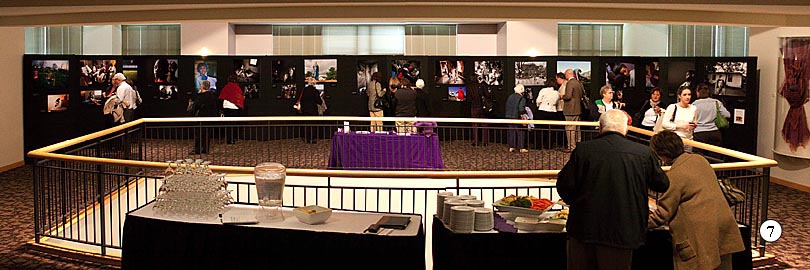
7)
T+x: From St. Paul, the exhibit moves to Portland,
Oregon and then begins a nine city nationwide tour,
with the goal of ending at the White House in 2010.
Math,
art and terrorists in a single blog entry. Now that
is efficient blogging.
The Shell takes shape...
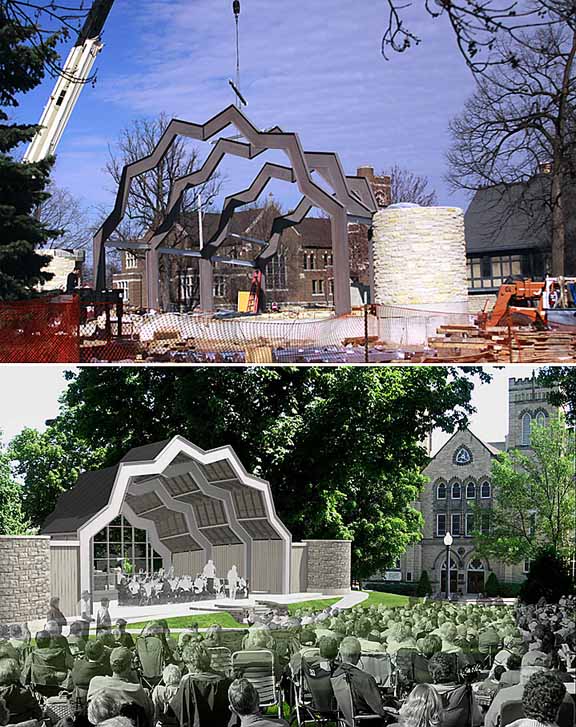
The
Central Park Bandshell took a big leap forward
yesterday when the crane arrived to install the
ironwork. The entire back wall will be glass, so the
bandshell will be inviting from both sides. The roof
shape is supposed to create a better acoustical
environment. The rendering on the bottom image is the
architectural orthographic projection.
The actual audience will not be semi-transparent.
Mr. Pin-up...
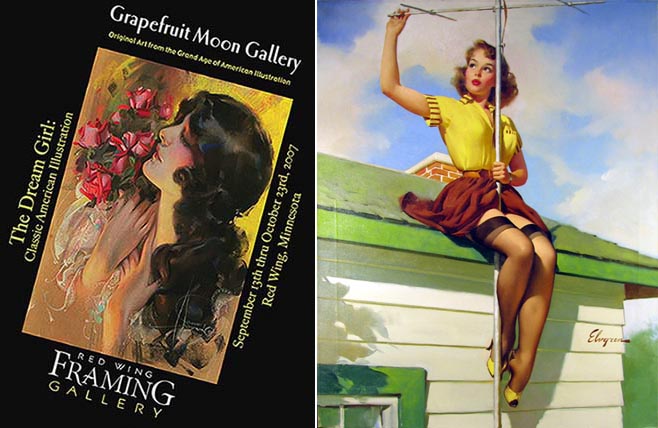
The
Minneapolis Star-Tribune did a nice story today about
Dan Murphy and his illustration art collection. We
had the pleasure of working with Dan and Sarah on two
different occasions; once in 2007 for The Dream Girl
exhibit and again in 2008 for The Cream of Wheat
exhibit.
Dan has a terrific collection and is a recognized
expert of this genre. I look forward to working with
Dan again this year, maybe with a pulp men's magazine
(think True Detective) or a science-fiction exhibit.
The Strib article can be found
here
The War on Poverty

Steve Liss is an accomplished photojournalist, as
evidenced by having 43 Time Magazine cover photos to
his credit.
But it isn't this professional success that Liss
takes the most pride in. Steve Liss is a humanitarian
who uses photo essays to communicate tough topics.
His subjects have ranged from poverty in the
Mississippi Delta, to runaway youth living on the
streets of Hollywood, to a study of the Nuns of
Mankato and Alzheimer's disease. He has been the
recipient of the Soros Justice Media Fellowship for
his work on juvenile justice and the Alicia Patterson
Fellowship for his work on domestic poverty.
We are delighted and excited to be asked to
participate in his latest project entitled;
In Our Own
Backyard: U.S. Poverty in the 21st
Century
(web site).
This is a unique poverty awareness project being
undertaken by 15+ preeminent American
photojournalists. The project goal is to use the
visual power of large-format documentary photography
to elevate the discussion of making the fight against
poverty a national priority.
This project is in partnership with Catholic
Charities and their campaign to cut poverty in half
by 2020. Nine major photographic and multi-media
exhibits, each with 50 emotionally-moving large
format photographs will tour throughout the United
States begining in the fall of 2009.
This project will be kicked off at a leadership
summit on April 20, 2009 at the College of St.
Catherine, St. Paul, MN. Registration is
here and an invitation postcard is here.
Poverty has many faces and it is impossible to ignore
when seen up close and personal. It is projects like
this that make work seem less like work and more like
purpose.
Upon further review...
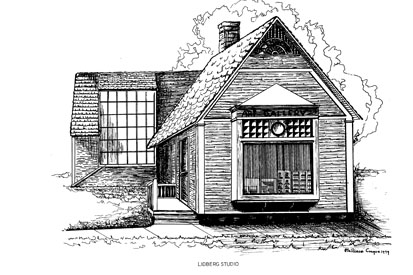
By going backwards through
telephone directories (this is known as a 'Jim
Rockford') and speaking with Barb Tittle, it was
possible to stitch together a more complete history
of this building.
This building has a very significant photography (and
real estate) lineage.
312 West Avenue chronology:
1894 - 1902 Lidberg
Studio (original location)
1902 - 1920 Lidberg Studio (new location)
1920 - 1936 E. H.
Lidberg Real Estate
1937 - 1947 Davison
Studio
1948 - 1949 Wood's Studio
1950 - 1952 Hodge Studio
1953 - 1979 Chalet Studio
1980 - 2004 InComm
Realty and Maas Realty (later
Coldwell-Banker)
2005 - 2007 Gary-Donald Arts, a private art dealer
2008 - Present Red
Wing Portrait Studio (and Red Wing Framing Gallery)
For 73
years, out of a total
115 years, this building has been home to
6
different photography studios. For 40
years out of this same
115 years, this building has been home to at
least 3 (if not 4) real
estate companies.
Draw your own conclusions.
This building has historical bones...
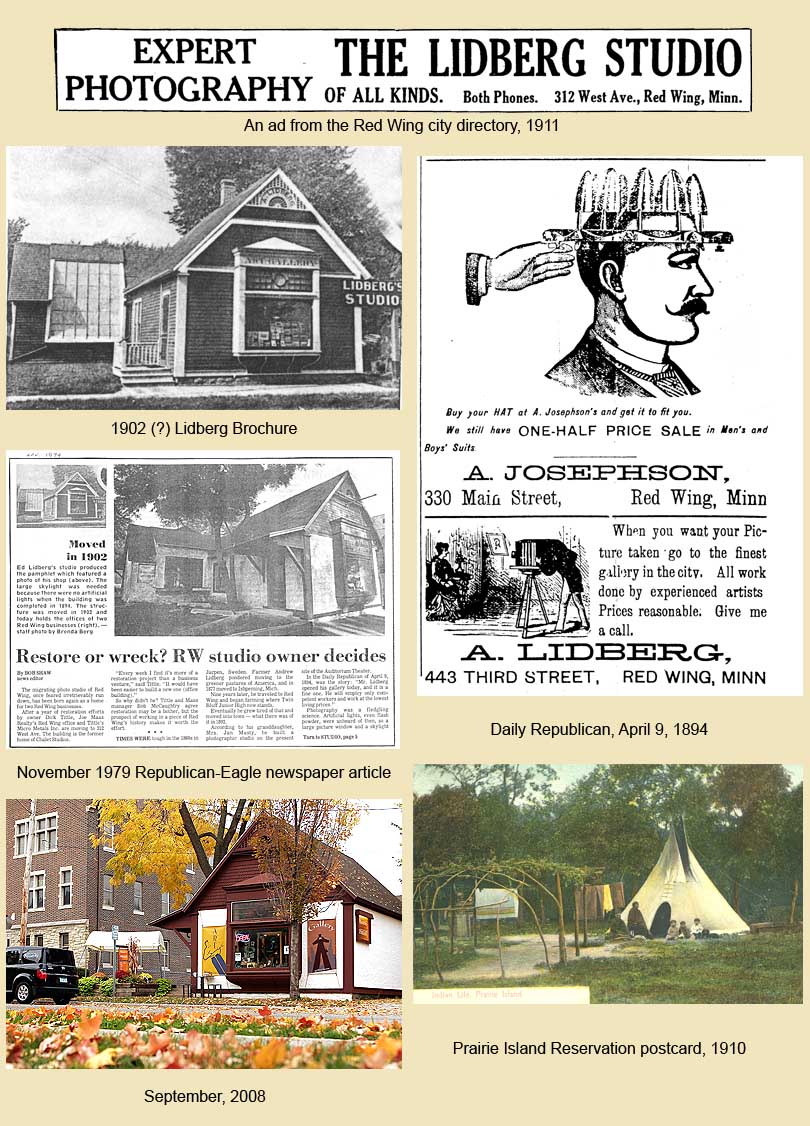
1894 - Andrew Lidberg, an immigrant
from Jarpen, Sweden builds and opens The Lidberg
Studio at 443 W. 3rd Street, Downtown Red Wing,
Minnesota (the corner of W. 3rd Street and East
Avenue), which is immediately next door to Charlie
Wah's Chinese Laundry. The Daily Republican on April
9th, 1894 writes, "Mr. Lidberg opened his gallery
today, and it is a fine one. He will employ only
competent workers and work at the lowest living
prices."
1899 - Upon graduating from Red Wing High School,
Andrew 's son Edward joins the studio full time. The
Lidberg's begin producing the first series of colored
souvenir post cards of Red Wing and the surrounding
area. The photos were exposed on glass plates and
developed at the studio. Negatives were then produced
and sent to Germany to be lithographed into color
post cards. These postcards are now collector items
with a passionate following.
1902 - Local businessman T.B. Sheldon donates money
to the City of Red Wing to build the country's first
city-owned theater. To make room for the Sheldon
Theatre, The Lidberg Studio is moved across the park
mall to 312 West Avenue where the building is located
today. A glass wall is oriented to the east to
provide natural light illumination for portraiture
photography.
1910? - Andrew Lidberg retires. Frank Booth, a
graduate of Effingham School of Photography in
Illinois, joins the studio.
1915 - Because of the war in Europe, it becomes
increasingly difficult do receive color lithographs
from Germany. Senator Knute Nelson has to intervene
to get a production run of postcards released.
Production is moved to Chicago (Acmegraph Company)
and Milwaukee (E.C. Kropp Company).
1915 - Edward Lidberg begins his real estate career
and the photography business begins to wind down. By
1920 the building is a full-time real estate office.
1920 - 1953 Very few building details. The best guess
at this point is that from approximately 1920 to 1936
it was a real estate office and from about 1937 until
1953 it was various photography studios.
1953 - The Chalet Studio opens. This portrait studio
is owned and operated by Ms. Louella Champs.
1972 - Edward Lidberg dies.
1978 - The Chalet Studio closes. The building is in
very rough shape with the roof in danger of
collapsing.
1979 - The building is repaired and restored by Dick
Tittle. It becomes home to InComm Realty and Maas
Realty
2008 - The building becomes home to Red Wing Framing
Gallery and Red Wing Portrait Studio.
What goes around, comes around. Even if it takes 114
years.
The Big Picture

Clare
Baker called last November for an interview for The
Big Picture magazine, which is a trade journal for
the wide-format printing industry. The gist of the
article is about printers who have carved out a niche
business of providing wide-format, fine-art printing.
Wide-format printing is anything larger than 44" and
fine-art printing is usually defined as low-volume,
high-mix printing with tight duplication standards.
Over a period of weeks, Clare and I would
occasionally talk, but I lost track of the
publication date. I was pleasantly surprised to
receive the article in my mailbox this week. Clare
did her homework and did a terrific job of detailing
the priorities in wide-format fine-art printing:
1) Invest in capture, calibration and proofing
technologies.
2) Push the envelope in new applications and learn
from the failures.
An electronic version is right
here.
Max Becherer update...
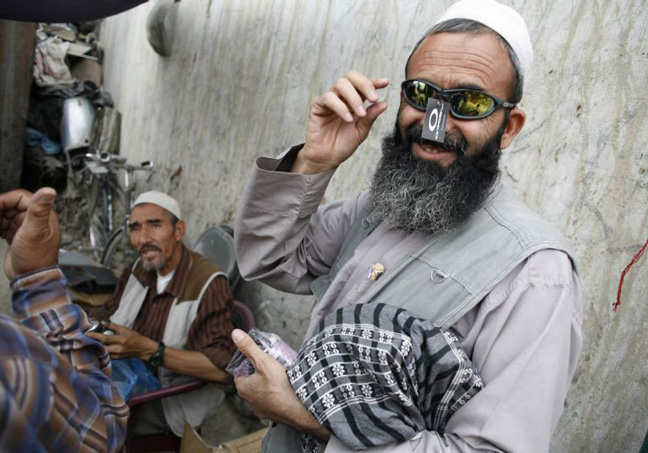
I
was delighted to get a note from Max Becherer this
morning. I have planted the seed of thought with Max
to begin to prepare a five year retrospective
photojournalism exhibit for next year. Max has been
in Iraq since the initial days of "Shock and Awe" and
has made a career of globetrotting to the hot spots
on the planet. But let Max speak for himself:
"Hi John!
So good to hear from you. I hope you are having a
great New Year! I am in Cairo, Egypt at the moment
but should be heading to Iraq for the Provincial
Elections later this month. I also think it will be a
good place to be when Obama takes office. I was up at
the Egyptian Border with Gaza last week and watched
as Israeli bombs blow up the tunnels and as the
Palestinian wounded came over on their way to
Egyptian hospitals. It was a difficult scene. I was
waiting for a chance to enter Gaza but they are
keeping a tight lid on things there.
So, your idea sounds great. I would love to do a five
year retrospective. There are so many ways we could
go with it for sure. I have a portfolio book of
images I collected from the last five years.
Last year I started covering the elections in
Pakistan. It was interesting and I was even able to
head up to Peshawar where the North West Territory
begins. What a wild place. In any case, I was in Iraq
at the last part of this year for the New York Times
and then did an assignment about Samarra for the
Smithsonian Magazine which is on newsstands now. This
week I head to Baghdad for a month and then in April
I will be in Afghanistan where things are expected to
be difficult this year. That is all for now.Thanks
for checking in with me. I hope we get to see each
other soon. Say hello to the crew for me!
Best,
Max"
Cream of Wheat; 1913-1925
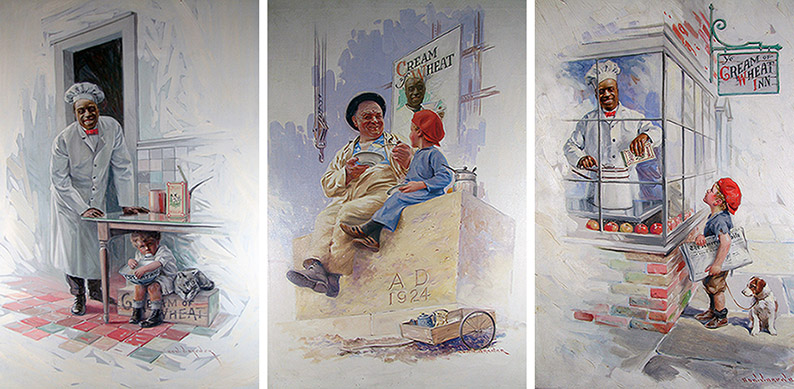
This week we decided to host our first major exhibit
at our new location. It is an exhibit of original art
from the Cream of Wheat advertising campaign from the
period of 1913-1925. It begins on October 10, 2008,
which doesn't leave much runway for a show of this
magnitude, but it was a fairly spontaneous decision
on the part of all the players involved.
The worst thing an art gallery can do is be boring,
and this exhibit is anything but.
This exhibit is fascinating on many levels. To begin
with, the art is amazing. The campaign director was
very insistent on using the best available
illustration artists and the art reflects that. The
imagery is very wholesome and comforting and humor is
a common element in many of the illustrations.
The exhibit also presents and
discusses the use of racial stereotypes in the media.
Times change and so do acceptable standards. The
Cream of Wheat campaign usually used an
African-American chef as a welcoming and reassuring
icon. Was this naive, demeaning or enlightened on the
part of Cream of Wheat?
And finally, Cream of Wheat went from a minor grain
mill in North Dakota to a major worldwide cereal
company in ten years because of their effective use
of advertising and image branding. This alone is
worthy of a Harvard business case study.
Cream of Wheat was located in Northeast Minneapolis
from 1897 to 2002. The company has changed hands
several times and is no longer independent. These
paintings were in storage in the archives of the
headquarters until the building was converted to
condominiums in 2005. This might be the last
opportunity to see a body of work this complete.
The best part of this exhibit is the chance to work
with Dan and Sarah again. We first worked with them
last year for The Dream Girl exhibit and they are a
class act. Maybe next year we can do a pulp fiction
or science fiction theme?
Leah Lundgaard
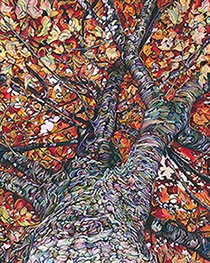
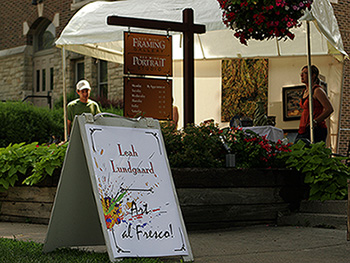
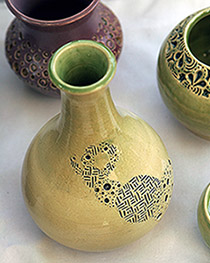
Leah
Lundgaard is the latest 'Art al fresco' artist. We
came to know Leah several years ago and have enjoyed
watching her grow as an artist over the years. Leah
is a full time artist and is both a painter and a
potter.
She typically paints with either a watercolor pencil
or with oils. A common element in her paintings is a
burst of color and activity, i.e., fall leaves or
waves crashing on beach rocks.
Her pottery has an interesting pattern of geometry. I
see a Fibonacci sequence in her patterns. This is a
common sequence found in nature. Sunflower heads,
honeybee combs and artichoke flowers are all examples
of Fibonacci patterns.
Leah is modest and soft-spoken and a very genuine
person. She clearly has an inner voice that she
expresses with her art. Visit her website at:
www.triple-l-design.com
and
buy lot's of her art. Right now.
The fine art of fine art printing...

Fine art printing is one of my favorite aspects of this business.
Printing is a nuanced science. By this, I mean that printing can be defined in technical terms, but it is the final perception by the viewer that defines the print impact.
But it isn't rocket science and it isn't brain surgery.
The first thing a fine-art print shop needs to accomplish is having all of the devices interpret color the same. This is a closed loop calibration and this normalizes the environment. Outside the loop, colors might shift, unless the device outside the loop is given the same calibration specifications. Color calibration does require regular re-calibration because of temperature and humidity changes.
That solves the issue of repeatability. The next step is accuracy.
Accuracy requires understanding the personality of the devices and the media. Every media has unique characteristics. We create about 1200 color patches for each media we use. These patches are read back into the computer with a photospectometer (a device that reads color) and a compensation file is created based on the expected versus the actual color values. This color profile is used by the printer to compensate for any color shifts.
However, there is an infinite number of color frequencies between each of the 1200 patches and this is where the media personalities comes into play. Does the media like blue frequencies? How well does it contrast? How bright is the base material? Stuff like that.
Fine-art printing can be somewhat iterative, but it isn't 'black magic'. I smile every-time I hear a printer try to make the process sound so mysterious.
So anyway, lot's of variables and each project is unique.
Good times and Save the Chief.
Jon Hassler 1933-2008
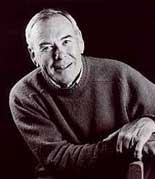
Goodbye Jon. And thank you for sharing all of your talents.
Blog from the Baghdad Bureau
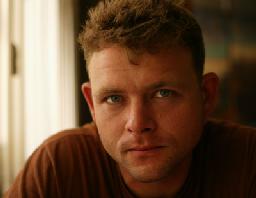
In September 2005 we hosted a photojournalism exhibit by Max Becherer. Max was an embedded photographer in the initial 'Shock and Awe' invasion of Iraq in 2003 and has been back and forth between Iraq and Afghanistan several times, usually for months at a time. Max's exhibit presented several story-lines of what life in Iraq is like for Iraqis in the post-Saddam era. The objective of the exhibit was to present an honest portrayal; it is what it is.
It was a very moving exhibit and I am proud to have Max as a friend. Max is a giant of a man who has an uncanny eye to capture the emotion within an image. This can be some pretty horrific combat photography and it takes a very special skill set to be both sensitive to the subject matter and still tell the story.
Max has some very emotional reflections on the past five years in Iraq. It was published in the New York Times on March 18, 2008. It can be found here. After you read that, visit his web site. www.MaxBecherer.com
To Max; keep your head low and travel safely.
